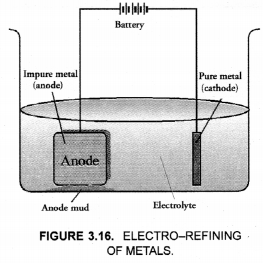Chapter 8 How do Organisms Reproduce Class 10 Science Important Questions with Answers PDF will help you in scoring more marks. This consists of 1 mark Questions, 3 Mark Numericals Questions, 5 Marks Numerical Questions and previous year questions from Chemical Reactions and Equations Chapter.
How do Organisms Reproduce Class 10 Important Questions and Answers Science Chapter 8
Very Short Answer Questions
Question 1.
Write the full expansion of HIV.
Answer:
Human immuno-deficiency virus.
More Resources
- Previous Year Question Papers for CBSE Class 10 Science
- NCERT Solutions for Class 10 Science
- NCERT Exemplar Solutions for Class 10 Science
- Value Based Questions in Science for Class 10
- HOTS Questions for Class 10 Science
Question 2.
Write the full form of IUCD.
Answer:
Intra-uterine contraceptive device.
Question 3.
Name the type of fission carried out by Amoeba.
Answer:
Binary fission.
Question 4.
What is vegetative propagation ? (CBSE Delhi 2006 C)
Answer:
It is the formation of new plants from vegetative parts (e.g., stem, leaf, root, bud) of a parent plant.
Question 5.
List two functions performed by ovaries in a human female. (CBSE A.I. 2006 C)
Answer:
- Formation of ova
- Secretion of hormones, estrogen and progesterone.
Question 6.
What is the effect of DNA copying which is not perfectly accurate in the reproductive process ?.
(CBSE A.I. 2008)
Answer:
It produces mutations which give rise to useful, harmful and neutral variations in the progeny.
Question 7.
Name the hormone, secretion of which is, responsible for dramatic changes in appearance in girls when they approach 10-12 years of age.
Answer:
Estrogen (= oestrogen) produced by growing follicles inside the ovary.
Question 8.
Why is DNA copying an essential part of the process of reproduction ?
Answer:
Cell multiplication is essential for reproduction either as a means of multiplication in unicellular organisms or as a means of development of multicellular body from a single celled zygote. Cell multiplication cannot occur without DNA replication or DNA copying because each new cell must carry the full DNA complement.
Question 9.
Mention the common mode of reproduction found in
- Amoeba
- Planaria.
Amoeba Binary fission in any plane.
Answer:
Planaria: Transverse binary fission.
Question 10.
Name any two types of asexual reproduction.
Answer:
Fission, Spore formation.
Question 11.
State the method used for growing rose plants.
Answer:
Artificial method of vegetative propagation by stem cuttings and bud grafting.
Question 12.
State what type of method is used for growing jasmine plant.
Answer:
Layering, a type of artificial method of vegetative propagation.
Question 13.
No two individuals are absolutely alike in a population. Why ?
Answer:
Due to presence of variations.
Question 14.
“Cell division is a type of reproduction in unicellular organisms”. Justify. (CCE 2013)
Answer:
In unicellular organisms cell division is a mode of reproduction as it produces two individuals or daughters by division of the parent cell.
Question 15.
Name the type of reproduction which
(a) involves gametes
(b) Does not involve gametes. (CCE 2013)
Answer:
(a) Sexual reproduction
(b) Asexual reproduction.
Question 16.
Define puberty. (CCE 2014)
Answer:
It is the beginning of development for sexual maturity which occurs at the age of 10-14 years in girls and 13—15 years in boys. Fully formed primary sex organs start secreting hormones for slow development of secondary sex organs and secondary sex characters.
Question 17.
Name the life process of an organism that helps in the growth of its population. (CCE 2015)
Answer:
Reproduction.
Question 18.
Name two simple organisms having the ability of regeneration. (CCE 2015)
Answer:
Hydra, Planaria.
Question 19.
Where is DNA found in the cell ? (CCE 2015)
Answer:
Nucleus, plastids and mitochondria.
Question 20.
Name the type of reproduction mostly seen in unicellular organisms. (CCE 2015)
Answer:
Asexual reproduction through cell division as binary fission, multiple fission, sporulation, budding.
Question 21.
Define sexual reproduction. (CCE 2015)
Answer:
It is a mode of reproduction in which offspring are formed by the process of formation and fusion of gametes.
Question 22.
In human female reproductive system where does fertilization occur ?
Answer:
In fallopian tube at ampulla—isthmus junction.
Question 23.
Name the parts where germ cells of a flower are located.
Answer:
Male — in anther of stamen.
Female — in ovule of carpel.
Question 24.
Name the part of Bryophyllum where buds are produced for propagation.
Answer:
Leaf notches.
Question 25.
What is DNA ?
Answer:
DNA or deoxyribonucleic acid is a self replicating biochemical that is carrier of genetic information for expression of hereditary traits and transfer to the next generation.
Question 26.
What happens when a planaria gets cut into two pieces ?
Answer:
Each piece grows (regenerates the missing parts) to form a complete animal.
Question 27.
Name the method by which Hydra reproduces commonly. Is this method sexual or asexual ?
(CBSE Foreign 2016)
Answer:
Hydra reproduces commonly by budding (also regeneration). It is a method of asexual reproduction.
Question 28.
List two unisexual flowers. (CBSE Foreign 2016)
Answer:
Water Melon, Papaya.
Question 29.
Why is fertilization not possible without pollinatign ? (CBSE Foreign 2016)
Answer:
Fertilization requires bringing of male gametes to the female gamete which is possible only when pollen grain is brought from the anther to the stigma in the process of pollination.
Question 30.
What happens when a mature Spirogyra filament attains considerable length ? (CBSE A.I. 2016)
Answer:
The elongated mature filament of Spirogyra breaks to form smaller pieces or fragments. The fragments grow to form mature filaments. .
Question 31.
What are those organisms called which bear both the sex organs in the same individual ? Give one example of such organism. (CBSE A.I. 2016)
Answer:
Bisexual or hermaphrodite, eg., Mustard, Hydra.
Question 32.
List two functions of ovary of human female reproductive system. (CBSE A. I. 2016)
Answer:
- Formation of ova
- Secretion of hormones estrogen and progesterone.
Question 33.
Name the method by which Spirogyra reproduces under favourable conditions. Is this method sexual or asexual ?
(CBSE Delhi 2017)
Answer:
- Fragmentation
- Asexual method.
Question 34.
Flow does Planaria reproduce ? Is this method sexual or asexual ? (CBSE Delhi 2017)
Answer:
- Transverse binary fission and regeneration
- Asexual method.
Question 35.
How does Plasmodium reproduce ? Is this method sexual or asexual ? (CBSE A.I. 2017)
Answer:
- Multiple fission,
- Asexual method.
Question 36.
When a cell reproduces, what happens to its DNA ? (CBSE A.I. 2017)
Answer:
DNA replicates and forms its copy at the time of cell reproduction.
Question 37.
Newly formed DNA copies may not be identical at times. Give one reason. (CBSE A.I. 2017)
Answer:
Error in DNA copying due to incorporation of wrong nucleotide.
Question 38.
Why is variation important for a species ? (CBSE A.I. 2017)
Answer:
Variation provides adaptability to changing environment and increased fitness in the struggle for existence.
Question 39.
Name the organs producing
(i) male germ cells / sperms and
(ii) female germ cells / ova respectively in humans. (CBSE Foreign 2017)
Answer:
(i) Testis
(ii) Ovary.
Question 40.
What is fertilisation ? Where does it occur in a human female ? (CBSE Foreign 2017)
Answer:
Fertilisation is the fusion of male and female gametes to form diploid zygote. In human female, it occurs in ampulla part of fallopian tube.
Short Answer Questions (2 Marks Each)
Question 1.
List any two differences between pollination and fertilization. (CBSE Delhi 2008, 2009, 2010)
Answer:
| Pollination | Fertilization |
| 1. Definition. It is transfer of pollen grains from anther to the stigma of a flower. 2. Step. Pollination precedes fertilization. 3. Purpose. It carries the male gamete producing pollen grains to the female sex organ. 4. Process. Pollination is a physical process. 5. Occurrence. It occurs only in seed plants. | It is the fusion of male and female gametes. Fertilization occurs only after pollination when the pollen grain has germinated and male gametes are carried into ovule. It actually brings about fusion of gametes. Fertilization is a physico-chemical (biological) process. It occurs in both plants and animals of various types. |
Question 2.
What is reproduction ? Mention the importance of DNA copying in reproduction. (CBSE Delhi 2008)
Answer:
Definition: Reproduction is the process of producing new young individuals of similar type by the mature individuals.
Importance of DNA Copying.
DNA carries hereditary information not only for controlling cellular functions but also all the structural and functional traits of organism. It is because of the latter that single celled zygote is able to form the whole multicellular organism. During reproduction there is formation of new cells which must carry the same amount and type of hereditary information as present in the parent cell. This is accomplished by DNA copying, which occurs prior to each cell division. DNA copying is not error proof. Errors give rise to variations.
Question 3.
Define variations in relation to a species. Why is variation beneficial to the species ? (CBSE Delhi 2008, CCE 2013)
Answer:
Definition: Variation is differences in structure, physiology and other characters found in the individuals of the same organism.
Benefits of variations to species.
Many of the variations are pre-adaptations which have no immediate benefit to the individuals. However, they remain in the population. Whenever, environment undergoes a drastic change, the pre-adaptations present in some members of the population allow the latter to survive, grow and regain its former size. Therefore, it is not necessary that variations are beneficial to individuals developing them but can prove useful to the species.
Question 4.
Mention the information source of making proteins in the cell. What is the basic event in reproduction ?
(CBSE Delhi 2008, 2009 C)
Answer:
Information Source: The information source of making proteins in a cell is its DNA.
Basic Event in Reproduction: The basic event in reproduction is replication of DNA, growth of cellular machinery and cell division.
Question 5.
Name one sexually transmitted disease each caused by a bacterial infection and viral infection. How can they be prevented ? (CBSE A.I. 2008, CCE 2012)
Answer:
Bacterial STD. Gonorrhoea caused by Neisseria gonorrhoeae. Viral STD. Genital warts caused by Human Papilloma virus.
Prevention. Avoiding multipartner sex, use of condoms and clean toilet habits.
Question 6.
(a) In human body what is the role of
- seminal vesicles and
- prostate gland.
(b) List two functions performed by testes in human beings. (CBSE A.I. 2008, 2009, CCE 2013)
Answer:
(a)
- Seminal Vesicles: They secrete 60-70% of semen plasma that is alkaline and viscous having fructose (for nourishing the sperms), fibrinogen, proteins and prostaglandins. Prostaglandins cause movements in the genital tract of the female. Sperms are also activated by secretion of seminal vesicles.
- Prostate Gland: It produces 20-30% of semen plasma. The secretion is alkaline and viscous. It has clotting enzyme and chemical essential for sperm activity.
(b) Function of Testes,
- Formation of sperms from germinal cells of seminiferous tubules.
- Secretion of testosterone by Leydig cells present in the connective tissue in between the seminiferous tubules.
Question 7.
Name the male and female gametes in animals. What is fertilization and where does it take place in human females ? (CBSE Delhi 2009)
Answer:
Male Gamete: Sperm (= spermatozoan)
Female Gamete: Ovum.
Fertilization: It is the fusion of two compatible gametes (e.g., sperm and ovum) to form diploid zygote during sexual reproduction.
In human females fertilization occurs in fallopian tube.
Question 8.
What is reproduction ? What are the two types ? Which one of the two confers new characteristics on the offspring and how ? (CBSE A.I. 2009 C, 2017)
Answer:
Reproduction: Reproduction is the process of producing new young individuals of similar type by the mature individuals.
Importance of DNA Copying.
Types. Asexual reproduction and sexual reproduction.
New Characteristics: New characteristics appear only in sexual reproduction due to
- Chance separation of chromosomes during meiosis required for gamete formation,
- Crossing over during meiosis.
- Chance coming together of chromosomes during fertilization,
- Mutations or mistakes during DNA replication.
Question 9.
What is binary fission ? Draw a diagram to show binary fission in Amoeba. (CBSE A.I. 2009 C)
Answer:
Binary Fission. It is a mode of asexual reproduction in a mature individual which splits up or divides to form two individuals.
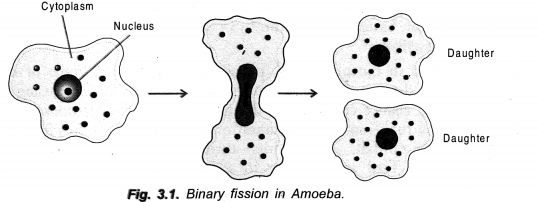
Question 10.
What is regeneration ? State a reason why a more complex organism cannot give rise to new individuals through this method. (CBSE A.I. 2009 C)
Answer:
Regeneration. It is ability of an individual to form lost or broken parts, sometimes the entire individual I from a piece of the parent body. The ability to form the whole individual from a piece of parent body is
found only in simple animals like Hydra and Planaria. It does not occur in complex organisms like humans, birds, lizards etc. Here regeneration is limited to repair or regeneration of minor parts. It is because the tissues and organs are highly differentiated in complex animals.
Question 11.
With the help of diagram, show the different stages of binary fission in Amoeba. (CBSE Delhi 2010)
Answer:
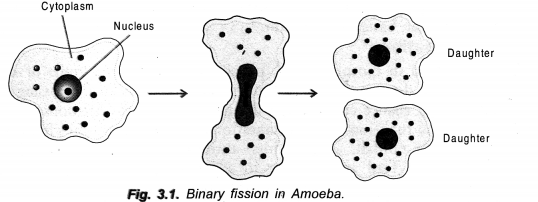
- Pseudopodia shorten,
- Nucleus elongates and divides into two.
- The perent cleaves in between the two daughter nuclei to form two daughter individuals.
Question 12.
State in brief two junctions ofcopper-T used by some women. (CCE 2011)
Answer:
- Destruction of sperms
- Prevention of implantation.
Question 13.
(a) Give reason : Regeneration is not the same as reproduction.
(b) State the mode of asexual reproduction in Plasmodium. (CCE 2011)
Answer:
(a) Regeneration is not the same as reproduction as no propagule is formed and no organism will depend on being cut to be able to reproduce.
(b) Multiple fission.
Question 14.
How does Rhizopus multiply by spores. Explain in brief. Sketch neat labelled diagram of this method.
(CCE 2011)
Answer:
Spores of Rhizopus are nearly always present in the air. They settle down on moist organic matter like bread, germinate and form mycelia. A mycelium bears a number of black aerial blobs or sporangia wherein spores are | formed. The wall of sporangium breaks and the released spores are picked up by air for dispersal. Draw

Question 15.
(i) List two reproductive parts of a flower.
(ii) How is a unisexual flower different from a bisexual flower ? State in brief. (CCE 2011)
Answer:
(i) Male — Stamen.
Female — Carpel/Pistil
(ii) A unisexual flower possesses one types of reproductive organs, either stamens (staminate or male flower) or pistils (pistillate or female flower) while a bisexual flower has both the types of reproductive organs.
Question 16.
In what respect is the human male gamete different from the female gamate ? What is the importance of this difference ? (CCE 2011, 2014)
Answer:
Male gamete or sperm is smaller, dart-like motile gamete with scanty amount of food reserve. Female gamete or ovum is larger, rounded, non-motile gamete with a good amount of reserve food. The difference helps the ovum to get loaded with cytoplasmic contents and allow the sperm to swim freely upto the ovum.
Question 17.
What will happen when (a) A mature Spirogyra filament attains considerable length
(b) Planaria gets cut into two pieces ? (CCE 2011)
Answer:
(a) Spirogyra genrally undergoes fragmentation with each fragment or smaller piece growing to form long ‘ filament.
(b) Each piece of Planaria regenerates or grows the missing parts to form the complete animal.
Question 18.
What are sexually transmitted diseases ? Name an STD which damages the immune system of human body.
(CCE 2011)
Answer:
Sexually transmitted diseases (STDs) or venereal diseases (VDs) are infectious diseases that are transmitted by
sexual contact between a healthy person and an infected person. STD that damages the immune system is HIV-AIDS.
Question 19.
(a) Surgical methods can be used to create a block in the reproductive system for contraceptive purposes. Name such parts where blocks are created in
- Males
- Females.
(b) State any two reasons for using contraceptive devices. (CCE 2011)
Answer:
(a)
- Vasa deferentia
- Fallopian tubes.
(b) Contraceptive devices are used to prevent pregnancy for
- Limiting size of family by spacing birth of children
- Avoiding unwanted pregnancy.
Question 20.
What is vegetative propagation ? Write two of its advantages. (CCE 2011, 2012, 2013, 2014)
Answer:
Vegetative propagation is the formation of new plants by using vegetative parts of a parent plant as propagules e.g., stem (Sugarcane, Bougainvillea, Potato), root (Sweet Potato, Dahlia), leaf (Bryophyllum), bud (Agave).
Advantages:
- It is the only known method of multiplication of seedless plants like Banana and Sugarcane.
- It is a quicker method as vegetatively reproduced plants bear flowers and fruits earlier than plants raised through seeds.
- All the individual plants are clones of one another and their parent so that the crop is genetically uniform.
- Good quality of a variety can be maintained indefinitely.
Question 21.
Name the type of asexual reproduction in
(a) Planaria
(b) Rhizopus
(c) Spirogyra
(d) Hydra. (CCE 2011)
Answer:
(a) Planaria —regeneration,
(b) Rhizopus — spore formation
(c) Spirogyra — fragmentation
(d) Hydra — budding.
Question 22.
Differentiate between
(a) Asexual reproduction and sexual reproduction
(b) Self pollination and cross pollination.
(CCE 2011, 2012)
Answer:
(a) Asexual reproduction is monoparental, with no gametes, no meiosis and very little variations. Sexual reproduction is generally biparental involving fusion of gametes, meiosis and lot of variations.
(b) Self pollination is transfer of pollen grains from the anther to the stigma of the same flower (e.g., Commeliria, Wheat) while cross pollination is transfer of pollen grains from the anther of one flower to the stigma of another flower of the same species (e.g., Salvia).
Question 23.
State two points of importance of DNA copying in reproduction. (CCE 2011, 2012)
Answer:
- Copying of DNA during reproduction provides the same and full complement of DNA to each and every cell which is important because DNA controls not only cellular functions but also structural and functional traits of the individual.
- Copying of DNA is not one hundred percent fool proof. Some variations develop due to small errors in copying.
Question 24.
How does the process of budding differ from the process of spore formation ? (CCE 2011)
Answer:
| Budding | Spore Formation |
| 1. Number: One or a few buds develop over the body of an individual. 2. Dispersal: It is limited. 3. New Individual: The bud directly grows into a new individual. Ex. Hydra. | A very large number of spores develop from an individual. Spores are dispersed far and wide. A spore germinates and then forms a new individual. Ex. Rhizopus. |
Question 25.
(a) Out of the following plants, which two plants reproduce by vegetative propagation : Jasmine, Wheat, Mustard, Banana ?
(b) List any one advantage of practising this kind of propagation. (CCE 2011)
Answer:
(a) Jasmine (layering), Banana (cutting of rhizome).
(b) Advantages:
- It is the only known method of multiplication of seedless plants like Banana and Sugarcane.
- It is a quicker method as vegetatively reproduced plants bear flowers and fruits earlier than plants raised through seeds.
- All the individual plants are clones of one another and their parent so that the crop is genetically uniform.
- Good quality of a variety can be maintained indefinitely.
Question 26.
Illustrate the process of regeneration in Planaria with help of a suitable diagram. (CCE 2011)
Answer:
On being cut or broken into two or more pieces, each piece grows to form the complete animal of Planaria. It is done with the help of
- dedifferentiation of differentiated cells and
- reserve cells which proliferate, reach the exposed parts and differentiate to form the missing regions.
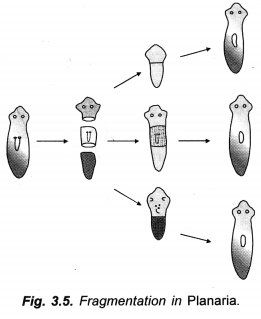
Question 27.
Leaves of Bryophyllum fallen on the ground produce new plants. Why ? (CCE 2011)
Answer:
Leaves of Bryophyllum bear adventitious buds in thè marginal notches. As the leaves fall down on the ground and come in contact with soil, the buds sprout and form new plants.
Question 28.
State the significance of human testes being located in the scrotum. (CCE 2011, 2012)
Answer:
- Scrotum not only protects the testes but also acts as a thermoregulator by changing position of the testes.
- It keeps the temperature of testes 1 -3° C below that of the body. A lower temperature is essential for development of sperms.
Question 29.
(a) What will happen to ovary and ovule after fertilization in angiospermic plants ?
(b) Name two animals that reproduce asexually.
(c) What are the male and female gonads in human beings known as ? (CCE 2011)
Answer:
(a) Ovary — fruit.
Ovule — seed.
(b) Hydra, Sponges
(c) Male Gonads —Testes.
Female Gonads-Ovaries.
Question 30.
Protozoans reproduce by binary fission as well as multiple fission. In your opinion which process is better and why ? (CCE 2011)
Answer:
Multiple fission is better as
- it often occurs inside perennating cysts
- it produces many daughters.
Question 31.
In Tobacco plant, the male gametes have 24 chromosomes. State the number of chromosomes in
- Egg nucleus
- Zygote
- Endosperm
- Leaf cell. (CCE 2011)
Answer:
- 24
- 48
- 72
- 48.
Question 32.
The organisms formed by asexual reproduction are considered as clones Why ? State the advantage of sexual reproduction over asexual reproduction. (CCE 2011)
Answer:
Organisms formed through asexual reproduction are considered clones as they are genetically similar to one another as well as their parent.
Sexual reproduction is advantageous over asexual reproduction as it produces a lot of variations due to reshuffling of chromosomes and crossing over. This provides better adaptability, more vigour and vitality to the offspring.
Question 33.
(a) What is the site of implantation and development of young one in human female ?
(b) Mention two advantages of using mechanical barriers during sexual act. (CCE 2011)
Answer:
(a) Uterus,
(b)
- Non-transmission of STDs
- Prevention of pregnancy.
Question 34.
(a) Leaves of Bryophyllum fallen on ground produce new plants whereas the leaves of Jasmine do not. Why ?
(b) Write two points of differences between asexual and sexual reproduction. (CCE 2011, 2012)
Answer:
(a) Leaves of Bryophyllum possess adventitious buds in their marginal notches. The buds sprout to produce plantlets when leaves fall on soil. Leaves of Jasmine cannot undertake asexual reproduction as they do not develop adventitious buds.
(b)
| Asexual Reproduction | Sexual Reproduction |
| 1. Parents: It is monoparental. | It is generally biparental |
| 2. Meiosis: Meiosis does not occur during asexual reproduction. There are no gametes and no fertilization. | Meiosis occurs: Gametes are formed and fertilization occurs in sexual reproduction. |
| Ex: Binary fission in Amoeba, Budding in Yeast | Ex: Offspring in Wheat, Human. |
Question 35.
(a) Name the parts of the flower which ripens to form fruit and seed

(b) In the diagram, label A and B.
(CCE 2011)
Answer:
(a) Fruit — Ovary.
Seed — Ovule.
(b) A — plumule.
B — radicle.
Question 36.
With the help of a diagram only show regeneration in Planaria. Regeneration is not possible in all types of animals. Why ? (CCE 2011)
Answer:

- Regeneration is possible in only simple animals having reserve or stem cells.
- In complex higher animals regeneration is controlled by nervous and hormonal systems which become impaired at the site of injury.
Question 37.
How does the process of seed germination take place in plants ? Describe in brief. (CCE 2011)
Answer:
Seed germination occurs when a seed is placed in moist soil in such a way that it is also able to absorb oxygen from air. The seed absorbs moisture through its micropyle. The embryo becomes active. The seed coat softens. Seed interior swells causing breaking of seed coat. The radicle grows, passes out of the seed and enters the soil as root. The plumule, with or without cotyledons, comes out of soil and gives rise to shoot. The seedling becomes nutritionally independent.
Question 38.
Name the sex hormones secreted by male and female sex organs in human beings. State one function of each.
(CCE 2011)
Answer:
Male — Testosterone — Sperm formation and male characteristics.
Female —
- Estrogen — Release of ovum, maintenance of female characteristics,
- Progestérones— development of uterine lining.
Question 39.
(a) How is the process of pollination different from fertilization ?
(b) State the mode of reproduction in Earthworm, Frog, Rhizopus and Plasmodium (CCE 2011)
Answer:
(a)
Pollination | Fertilization |
| 1. Definition. It is transfer of pollen grains from anther to the stigma of a flower. 2. Step. Pollination precedes fertilization. 3. Purpose. It carries the male gamete producing pollen grains to the female sex organ. 4. Process. Pollination is a physical process. 5. Occurrence. It occurs only in seed plants. | It is the fusion of male and female gametes. Fertilization occurs only after pollination when the pollen grain has germinated and male gametes are carried into ovule. It actually brings about fusion of gametes. Fertilization is a physico-chemical (biological) process. It occurs in both plants and animals of various types. |
(b) Earthworm—sexual, also asexual.
Frog — sexual.
Rhizopus —spore formation, also sexual.
Plasmodium — multiple fission, also sexual.
Question 40.
Prenatal sex determination has been prohibited by law. State two reasons. (CCE 2011)
Answer:
- The test has been banned since due to desire of male child, there has been large scale female foeticide.
- This has resulted in declining female-male sex ratio.
Question 41.
What is placenta ? State its two roles during pregnancy. (CCE 2011)
Answer:
Placenta is a spongy vascular structure formed by the joint activity of maternal and foetal tissues in the wall of uterus that connects foetus with uterus.
Roles:
- Providing nutrition to the foetus.
- Taking away wastes of the foetus.
Question 42.
Compare the vegetative propagation of Bryophyllum and Money plant. (CCE 2011)
Answer:
In Bryophyllum, vegetative propagation occurs through the agency of leaves that fall on moist soil. In Money Plant, vegetative propagation occurs with the help of stem cuttings bearing at least one leaf and its axillary bud. A single leaf of Bryophyllum can produce several plants. A leafy stem cutting of Money Plant forms only a single plant.
Question 43.
(a) Where are the male germ cell and female gamete produced in a flower ?
(b) State the significance of variation in reproduction.
(c) Mention the principle of regeneration. (CCE 2011)
Answer:
(a) Male Germ Cell (Male Gamete). Formed inside the pollen tube or pollen grain from generative cell.
Female Gamete (Oosphere). Inside embryo sac part of ovule.
(b) Significance of Variation in Reproduction
- It provides individuality to each living organism,
- It helps individuals in the struggle for existence,
- Variation is a source of preadaptation.
(c) Principle of Regeneration: It is the ability of an individual to form lost or broken part, sometimes the entire individual from a piece of the parent body through dedifferentiation of mature cells and activity of reserve cells. The ability to form a new individual from a part of the body is well developed in simple animals like Hydra and Planaria. It is restricted to the formation of only broken parts in complex organisms.
Question 44.
(a) Name two bacterial STD infections.
(b) How do oral pills prevent pregnancy ? (CCE 2011)
Answer:
(a)
- Gonorrhoea caused by bacterium Neisseria gonorrhoeae
- Syphilis caused by bacterium Treponema pallidum.
(b) Oral pills contain progestin (= progesterone) alone or in combination with estrogen. They prevent pregnancy by inhibition of ovulation, making uterine wall unsuitable for implantation alongwith unsuitable changes in cervical mucus and activity of fallopian tubes.
Question 45.
Explain how ovary functions both as reproductive organ as well as endocrine gland. (CCE 2011)
Answer:
Reproductive Organ. Ovary produces ova, one every lunar month for possible fertilization and formation of foetus.
Endocrine Gland. Maturing ova or follicles present in ovary secrete oestrogen (= estrogen) while empty follicle develops into corpus luteum that secretes progesterone.
Question 46.
What is the information source in the cell nucleus for making proteins. State the basic events in reproduction.
(CCE 2011)
Answer:
- Information Source. DNA
- Basic Events in Reproduction. DNA replication, growth of cellular machinery and cell division.
Question 47.
(a) Why are budding, fragmentation and regeneration considered as asexual type of reproduction ?
(b) Which among the following reproduces by spore formation : Bryophyllum, Rhizopus, Hydra ?
(CCE 2011)
Answer:
(a) Asexual Reproduction: Budding, fragmentation and regeneration are all considered to be modes of asexual reproduction as they involve formation of new individuals from single parents without fertilization or fusion of gametes.
(b) Rhizopus.
Question 48.
Draw labelled diagram of
(a) Spore formation in Rhizopus
(b) Regeneration in Planaria. (CCE 2012)
Answer:
(a)
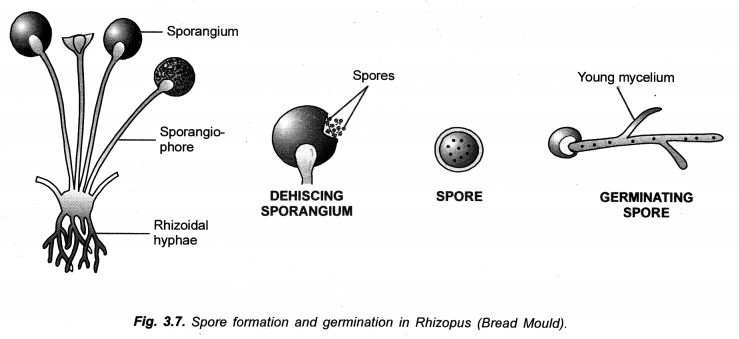
(b)
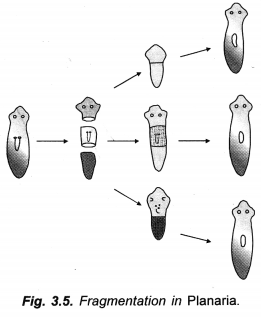
Question 49.
“Multicellular organisms cannot divide cell by cell”. List two reasons to justify this statement. (CCE 2012)
Answer:
- In multicellular organisms, cell by cell division is a method of growth and not a method of multiplication as in unicellular organisms.
- Multicellular organisms have developed complex and specialised reproductive structures which are not possible in single celled organisms.
Question 50.
(a) Name the process by which pollen grains are transferred from anther to stigma. Mention any one external agent which performs this process in some flowers. .
(b) Differentiate between its two types. Give one example of each. (CCE 2012)
Answer:
(a)
- Pollination
- Air/Insects.
(b) Two types, self pollination and cross pollination. Self pollination is transfer of pollen grains from the anther to the stigma of the same flower (e.g., Commeliria, Wheat) while cross pollination is transfer of pollen grains from the anther of one flower to the stigma of another flower of the same species (e.g., Salvia).
Question 51.
(a) Name the organ which helps in providing nutrition to embryo. Where is it located ?
(b) What causes the delivery of child from mother’s uterus ? (CCE 2012)
Answer:
(a) Placenta is the organ which provides nourishment to the embryo. It is formed jointly by embryo and uterus. Placenta is located in the uterus of the mother.
(b) Foetal ejection reflex is produced in response to signals from fully formed foetus and its supporting placenta.
Question 52.
List the modes of pollination and define each of them. (CCE 2012)
Answer:
Pollination is of two types, self pollination and cross pollination.
Self Pollination. It is the transfer of pollen grains from the anther to the stigma of the same flower, e.g., Commelina, Wheat.
Cross Pollination. It is the transfer of pollen grains from the anther to the stigma of another flower of the same species, e.g., Salvia.
Question 53.
(a) Differentiate between unisexual and bisexual flowers.
(b) Which of the following plants produce unisexual flowers : Watermelon, Hibiscus, Mustard, Papaya ?
(CCE 2012)
Answer:
(a) Unisexual flowers are those flowers which possess only one type of reproductive organs, either stamens or carpels. Bisexual flowers are those flowers which have both the types of reproductive organs, i.e., stamens and carpels.
(b) Watermelon, Papaya.
Question 54.
(a) List two events during binary fission in Amoeba.
(b) In which two of the following organisms, regeneration takes place : Lion, Planaria, Hydra, Lotus. (CCE 2012)
Answer:
(a)
- Elongation of nucleus followed by division into two.
- Cleavage of cytoplasm in between the two daughter nuclei to form two daughter cells.
(b) Regeneration. Planaria, Hydra.
Question 55.
(a) Which organ is responsible for implantation of zygote ?
(b) State the function of fallopian tubes. (CCE 2012)
Answer:
(a) Zygote (in the form of blastocyst) gets implanted in uterus with the help of villi.
(b)
- Fallopian Tubes,
- Conduct ovum from ovary to uterus,
- Fertilization occurs inside fallopian tube.
Question 56.
(a) Name the structure in human male reproductive system that delivers the sperms from the testes to the urethra.
(b) Name the structure in human female reproductive system which delivers the egg from the ovary to the uterus.
Answer:
(a) Vas deferens
(b) Fallopian tube.
Question 57.
(a) Write the advantage of sexual reproduction over asexual reproduction.
(b) Name the male and female parts of a flower. (CCE 2012)
Answer:
(a) Advantage of Sexual Reproduction. Sexual reproduction introduces variations and maintains the vigour and vitality of the individuals.
(b) Male—Stamens.
Female—Carpels.
Question 58.
(a) Differentiate between reproduction and regeneration.
(b) Name any two organisms which grow by regeneration. (CCE 2012)
Answer:
(a) Reproduction is the formation of new individuals by the grown up organisms with the help of propagules or germ cells. Regeneration is growth of injured parts of the individuals for repair and replacement of lost parts.
(b) Planaria and Hydra can grow by regeneration.
Question 59.
What is pollination ? How does it take place ? (CCE 2012)
Answer:
Pollination is the transfer of pollen grains from an anther to a stigma. Pollination between anther to the stigma of the same flower is called self pollination. It occurs through contact between the two.
Pollination between anther of one flower and stigma of another flower is cross pollination. It requires an external agency which may be abiotic (wind, water) or biotic (insects, birds, bats, worms, etc.).
Question 60.
How is the process of binary fission in Amoeba different from that of Leishmania ? (CCE 2012)
Answer:
In Amoeba, binary fission can occur in any plane. In Leishmania the plane of division is vertical.
Question 61.
Which parts/organs of the human reproductive system perform the following functions
(a) Site of fertilisation
(b) Production of ovum. (CCE 2012)
Answer:
(a) Site of Fertilisation. Ampulla-isthmus junction of fallopian tube.
(b) Production of Ovum. Ovary.
Question 62.
Which parts/organs of human reproductive system perform the following functions :
(a) Site of implantation of zygote
(b) Entry of sperms in female reproductive system. (CCE 2012)
Answer:
(a) Implantation. Uterus,
(b) Entry of Sperms. Vagina.
Question 63.
Give any two differences between radicle and plumule. (CCE 2012)
Answer:
- Radicle is the future root while plumule is the future shoot.
- Radicle does not bear leaf primordia that are present over the plumule.
Question 64.
List the suitable difference between pollen grain and ovule. (CCE 2012)
Answer:
- Pollen grain is a spore while ovule is a sporangium.
- Pollen grain is specialised to produce two male gametes. An ovule has generally a single female gamete.
Question 65.
“The chromosome number of sexually reproducing parents and their offspring is the same”. Justify this statement.
(CCE 2013)
Answer:
Both parents and their offspring have generally diploid chromosomes. Meiosis occurs during gamete formation so that gametes have haploid chromosomes. Fusion of gametes during sexual reproduction produces diploid zygote. The offspring develops from zygote.
Question 66.
(a) Trace the path of sperms from where they are produced in human body to the exterior.
(b) Write the functions of secretions of prostate çland and seminal vesicles in humans. (CCE 2013)
Answer:
(a)
Testis —> Epididymis —> Vas deferens —>Urinogenital duct
(b) Both the glands produce semen plasma, 60—70% by seminal vesicles and 20—30% by prostate gland. It is required for activation and transport of sperms.
Question 67.
List four methods of asexual reproduction other than fission in the living organisms. (CCE 2014)
Answer:
Budding, Fragmentation, Regeneration, Sporulation.
Question 68.
Draw labelled diagrams to illustrate budding in Hydra. (CCE 2014)
Answer:
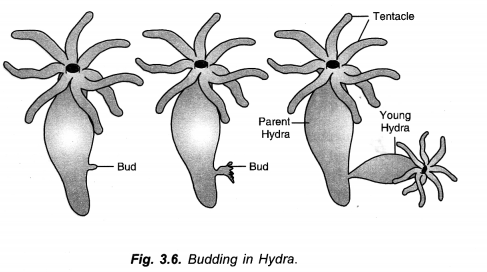
Question 69.
Students were asked to observe the permanent slides showing different stages of budding in yeast under the high power of microscope.
Answer:
(a) Which adjustment screw (coarse / fine) were you asked to move to focus the slides ?
(b) Draw three diagrams in correct sequence showidg budding in yeast.
Answer:
(a) Fine adjustment
(b)

Question 70.
While observing a slide of budding in yeast, a student performs the following steps :
- Place the slide on the stage and fix it using the clip,
- Adjust the mirror and diaphragm.
- Focus using low power,
- Adjust to high power. Are the sequence steps correct ? If not correct the sequence of steps. (CCE 2015)
Answer:
Correct.
Question 71.
A student was asked to identify a difference in the nucleus of binary fission of Amoeba and budding in yeast.
What would be the possible correct difference identified by her ? (CCE 2015)
Answer:
In binary fission of Amoeba, the nucleus divides first (before the cleavage of cytoplasm). In budding of yeast, nucleus divides later after the formation of protuberance for bud.
Question 72.
Draw a well labelled diagram of budding in yeast. (CCE 2015)
Answer:
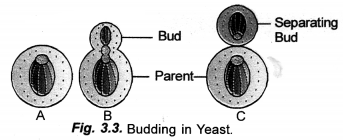
Question 73.
Name the type of asexual reproduction in which two individuals are formed from a single parent and the parental identity is lost. Draw the initial and the final stages of reproduction. State the event with this reproduction starts. (CCE 2015)
Answer:
Binary fission,
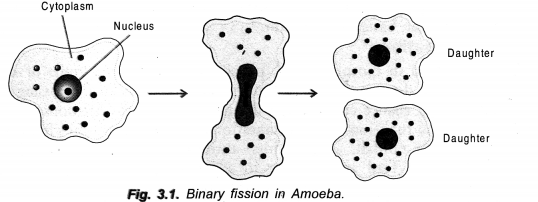
Binary fission starts with elongation and cleavage of nucleus.
Question 74.
A student observed the slide of binary fission of Amoeba under a microscope. What should be the observation reproted by him ? (CCE 2015)
Answer:
Study two permanent slides of Amoeba, one showing binary fission and other showing structure of the protozoan.
Nucleus is darkly stained. It appears elongated and constricted in the slide depicting binary fission. The same slide also
shows constriction of the body around the area of constricting nucleus.
Question 75.
What is meant by budding ? Explain with an example. (CCE 2015)
Answer:
Budding in Hydra. Some reserve cells present in the lower half of Hydra begin to divide due to some
internal or external stimulus. They form a cellular mound which grows into a bud. Soon the bud develops a mouth and tentacles. It makes the bud nutritionally independent. The bud constricts from base and separates as a new individual.

Question 76.
What does the diagram given here correctly illustrate ? Give reason in support of your answer.
(CCE 2015)
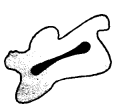
Answer:
Binary fission in Amoeba.
Reasons :
- Presence of elongated nucleus undergoing cleavage.
- Presence of pseudopodia.
Question 77.
Write two differences between binary fission and multiple fission in tabular form.
(CCE 2015)
Answer:
Binary Fission | Multiple Fission |
| 1. Products. It gives rise to two individuals. | It forms several (more than two) individuals. |
| 2. Conditions. Binary fission occurs under favourable conditions. | Multiple fission occurs both under favourable and unfavourable conditions. |
| 3. Nucleus. Nucleus of the parent cell divides only once to form two daughters. | Nucleus of the parent undergoes repeated divisions to form a number of daughter nuclei. |
| 4. Cytoplasm. Cytoplasm undergoes cleavage after each nuclear division. | Cytoplasm does not divide after every nuclear division. |
| 5. Residue. No part of the parent body is left unused. | A part of the body, covering and residual cytoplasm, is left behind. |
| Examples. Amoeba, Paramecium. | Examples. Plasmodium, Amoeba (encysted). |
Question 78.
Draw a labelled diagram to show that particular stage of binary fission in Amoeba in which its nucleus elongates and divides into two and a constriction appears in its cell membrane. (CBSE Delhi 2016)
Answer:
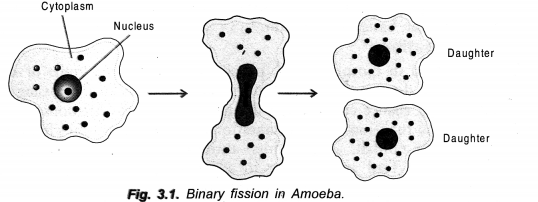
Question 79.
In which asexual reproduction two individuals are formed from a single parent whose identity is lost ? Draw the initial and final stages of this type of reproduction to justify your answer. Write the event with which this process starts. (CBSE Foreign 2016)
Answer:
Binary fission, e.g., Amoeba. first (initial) and third (final).
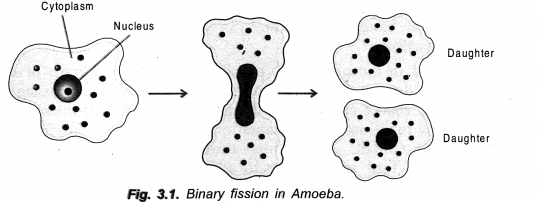
Question 80.
A student is observing a permanent slide showing sequentially the different stages of asexual reproduction taking place in yeast. Name this process and draw diagrams of what he observes in a proper sequence.
(CBSE A.I. 2016)
Answer:
Budding.

Short Answer Questions (3 Marks Each)
Question 1.
Define any three of the following terms used in relation to human reproduction,
- Fertilization (fertilisation)
- Implantation
- Placenta
- Gestation
- Parturition
- Ovulation.
(CBSE Foreign 2005, CCE 2011, 2012)
Answer:
- Fertilization: The union of male gamete (sperm) with the female gamete (ovum) to form a diploid zygote is called fertilization.
- Implantation: Fixation of young embryo (blastocyst stage) in the wall of uterus is called implantation.
- Placenta: It is a spongy vascular structure formed by the joint activity of maternal and foetal tissues in the wall of uterus that is meant for attachment, nourishment and waste disposal for the foetus.
- Gestation: It is a period between conception and birth of the live young one in mammals that is passed in the body of the mother.
- Parturition: The act of giving birth to a baby is called parturition.
- Ovulation: It is liberation of ovum from the ovary which in human beings occurs on 13-14 day of menstrual cycle due to surge of LH secretion.
Question 2.
Explain the terms “fission” and “regeneration” as used in relation to reproduction. (CBSE A. I. 2005)
Answer:
Fission. It is a mode of asexual reproduction in unicellular organisms in which a parent cell divides to form two or more individuals. In binary fission, a parent cell divides into two similar daughters, e.g., Amoeba, Paramecium, Leishmania. In multiple fission the contents of a unicellular individual divide into several daughters, e.g., Plasmodium.
Regeneration. It is the ability of an individual to form lost or broken part, sometimes the entire individual from a piece of the parent body through dedifferentiation of mature cells and activity of reserve cells. The ability to form a new individual from a part of the body is well developed in simple animals like Hydra and Planaria. It is restricted to the formation of only broken parts in complex organisms.
Question 3.
What is pollination. Name its two types. How do they differ from each other ?
(CBSE Delhi 2006, 2016, CCE 2011, CBSE Foreign 2016)
Answer:
Pollination: The transfer of pollens from anther to the stigma of a flower is called pollination.
Types: There are two types of pollination— self pollination and cross pollination.
Differences:
Self Pollination | Cross Pollination |
| 1. Flowers. It is the transfer of pollen grains from anther to stigma of same or genetically similar flower. | It is the transfer of pollen grains from the anther of one ‘ flower to the stigma of another flower. |
| 2. Pollen. Pollen grains are produced in small number. | Pollen grains are produced in large number. |
| 3. Agency. An external agency is not required. | An external agency is required for carrying of pollen grains from one flower to another. |
| 4. Variations. It does not produce variations. | It brings about a lot of variations. |
| 5. Vigour. There is a slow loss of vigour in self pollinated plants. | Vigour of the plants is maintained. |
| Ex. Commelina, Viola, Wheat. | Ex. Salvia, Bottle Brush, Bombax. |
Question 4.
What is vegetative propagation ? When is it used ? Name three methods of vegetative propagation.
(CBSE A.I. 2006 C)
Answer:
Vegetative Propagation: It is the formation of new plants from vegetative parts (e.g., stem, leaf, root, bud) of a parent plant.
When Used: Vegetative propagation is carried out during favourable period for obtaining fast growth of economically and horticulturally important plants. It is the only known method of propagation in seedless species and varieties of plants, e.g., Sugarcane, Banana.
Methods:
- Cuttings. Generally of stems but can also be of roots and leaves,
- Layering
- Grafting.
- Tissue culture or micropropagation is the latest technique for rapid multiplication of plants.
Question 5.
(a) What is fertilization ? Distinguish between external fertilization and internal fertilization.
(b) What is the site of fertilization in human beings ? (CBSE Delhi 2007)
Answer:
(a) Fertilization: The union of male gamete (sperm) with the female gamete (ovum) to form a diploid zygote is called fertilization.
Differences Between External and Internal Fertilization.
External Fertilization | Internal Fertilization |
| 1. Place. Fertilization occurs outside the body of the female. | Fertilization occurs inside the body of the female. |
| 2. Release of Gametes. Both the sexes discharge their gametes outside their body. | Only the male discharges the gametes and that also in the reproductive tract of the female. The female retains its gametes. |
| 3. Surety. It is not a sure method. | It is a sure method of fertilization. |
| 4. Embryo. Embryo develops unprotected, outside the body of the female. | Embryo is generally well protected but may develop outside or inside the body of the female. |
| Examples. Fishes, Amphibians. | Examples. Reptiles, Birds, Mammals, Insects, Spiders. |
(b) Site of Fertilization. Ampulla part of fallopian tube.
Question 6.
Define the terms unisexual and bisexual giving one example of each. (CBSE Delhi 2007)
Answer:
Unisexual. It is an organism having male and female sex organs on two different types of individuals, e.g., humans, Papaya.
Bisexual. It is an organism having both male and female sex organs present in the same individual, e.g., Rose, Mustard, Earthworm.
Question 7.
Explain double fertilization in plants. (CBSE A.I. 2007)
Answer:
Definition. The phenomenon of two male gametes fusing with different cells in the same embryo sac to produce two different structures is called double fertilization.
One male gamete fuses with oosphere (egg) to form diploid zygote. It is called generative fertilization. Zygote grows to form embryo. The second male gamete fuses with diploid secondary nucleus of central cell. It produces a triploid primary endosperm cell. The fusion is called triple fusion or vegetative fertilization. It produces a nutritive tissue called endosperm.
Question 8.
Illustrate the following with the help of suitable diagrams :
(i) Binary fission in Amoeba
(ii) Leaf of Bryophyllum with Buds. (CBSE A.I. 2008 C)
Answer:
(i) Binary Fission: It means ‘splitting into two’. Binary fission occurs under favourable conditions. When the unicellular individual has become mature, it divides to form two similar individuals. The parent disappears as its body gets distributed into its daughters. For binary fission, the nucleus or nuclear matter elongates and then divides into two. It is followed by cleavage of cytoplasm in between the two daughter nuclei to form two daughter individuals. In Amoeba, binary fission can occur in any plane (Fig. 3.1).
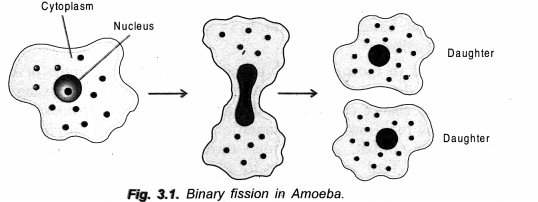
It occurs in a definite plane in unicellular organisms having more oganisation in their bodies. In Paramecium the plane of division is transverse. It is vertical in Euglena and Leishmania (the protozoan that has whip-like flagellum at one end and causes kala azar).
(ii) Leaf of Bryophyllum with Buds.
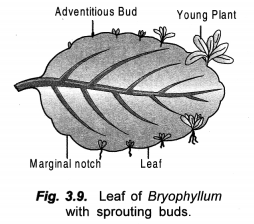
Buds occur in notches of Bryoplyllum leaf. They do not sprout in the intact leaf. However, when the leaf falls down and comes in contact with the soil, the buds sprout and produce plantlets.
Question 9.
(a) Explain the terms :
- Implantation
- Placenta
(b) What is the average duration of human pregnancy ? (CBSE Delhi 2008)
Answer:
(a)
- Implantation: Fixation of young embryo (blastocyst stage) in the wall of uterus is called implantation.
- Placenta: It is a spongy vascular structure formed by the joint activity of maternal and foetal tissues in the wall of uterus that is meant for attachment, nourishment and waste disposal for the foetus.
(b) Duration of Human Pregnancy. 270 days, considered 280 days from the time of previous menstruation.
Question 10.
What are sexually transmitted diseases ? Name four such diseases. Which one of them damages the immune system of human body ? (CBSE Delhi 2009)
Answer:
Sexually Transmitted Diseases(STDs). They are diseases which are transmitted through sexual contact with infected persons.
Examples:
- Gonorrhoea.
- Syphilis
- Genital Warts
- AIDS.
Damage to Immune System: AIDS caused by HIV (human immunodeficiency virus) damages human immune system because the virus multiplies in macrophages and helper T-4 lymphocytes.
Question 11.
List any three differences between pollination and fertilization.
Answer:
| Pollination | Fertilization |
| 1. Definition: It is transfer of pollen grains from anther to the stigma of a flower. 2. Step: Pollination precedes fertilization. 3. Purpose: It carries the male gamete producing pollen grains to the female sex organ. 4. Process: Pollination is a physical process. 5. Occurrence: It occurs only in seed plants. | It is the fusion of male and female gametes. Fertilization occurs only after pollination when the pollen grain has germinated and male gametes are carried into ovule. It actually brings about fusion of gametes. Fertilization is a physico-chemical (biological) process. It occurs in both plants and animals of various types. |
Question 12.
What is the full form of DNA ? Name the part ‘of the cell where it is located. Explain its role in the process of reproduction of the cell. (CBSE Delhi 2010)
Answer:
DNA: Deoxyribo-nucleic acid.
Location: Mostly in nucleus (small amount also in mitochondria and plastids).
Role in Cell Reproduction: DNA carries hereditary information not only for controlling cellular functions but also all the structural and functional traits of organism. It is because of the latter that single celled zygote is able to form the whole multicellular organism. During reproduction there is formation of new cells which must carry the same amount and type of hereditary information as present in the parent cell. This is accomplished by DNA copying, which occurs prior to each cell division. DNA copying is not error proof. Errors give rise to variations.
Question 13.
Explain vegetative propagation with the help of two examples. List two advantages of vegetative propagation.
(CBSE Delhi 2010)
Answer:
Vegetative propagation is the formation of new plants from vegetative propagules or parts (stem, leaf, root, bud) of a parent plant.
- Duranta/Bougainvillea. It is multiplied with the help of stem cuttings. 20-30 cm long stem pieces of one year old branches are placed in the moist soil in their natural position during spring or rainy season. The cuttings develop roots and shoots to form new plants.
- Jasmine/Grape Vine. It is multiplied by layering. One year old basal branch is defoliated in the middle, given a small cut (v-shaped, tongue-like or ring-like), pegged and covered with soil. The branch, now called layer, develops adventitious roots within 1-2 months. It is then separated as new plant.
Advantages:
- Seedless Plants. Vegetative propagation is the only known method of multiplication of seedless plants, g., Banana, Sugarcane, Pineapple, Jasmine, some varieties of Orange, Rose.
- Uniform Yield. Seeds and fruits are of uniform quality, size, taste and aroma.
- Genetic Uniformity. Vegetative propagation gives a genetically uniform population.
- Good Qualities. Good qualities of a variety can be maintained indefinitely.
- Survival Rate. Survival rate of the daughters is nearly 100% while in case of seed grown plants, it is 10%.
- Quicker Method. Vegetatively reproduced plants bear flowers and fruits earlier than the plants raised through seeds. Potato requires only three months for forming a new crop if raised from tubers. It takes 15 months if raised from seeds. ‘
- Introduction in New Areas. In areas where seed germination fails to form mature plants, vegetative reproduction can help in establishing the plants.
Question 14.
(a) Identify the asexual method of reproduction in each of the following organisms :
- Rose
- Yeast
- Planaria.
(b) What is fragmentation ? Name a multicellular organism which reproduces by this method. (CCE 2011)
Answer:
(a)
- Rose —stem cutting
- Yeast—Budding
- Planaria —regeneration.
(b) Fragmentation. It is the process of breaking up the body of an organism into two or more parts (called fragments), each of which grows into a new individual. Example. Spirogyra.
Question 15.
(a) How many eggs are produced every month by either of the ovaries in a human female ? Where does fertilization take place in the female reproductive system ?
(b) What happens in case of egg released by the ovary is not fertilized ? (CCE 2011)
Answer:
(a) One egg is produced every month by one of the two ovaries in a human female. Fertilization occurs inside the fallopian tube (ampulla isthmus junction).
(b) If the egg is not fertilized, it lives for one day and is then expelled. This also sets in motion the menstrual cycle. After about 12 days the corpus luteum (empty Graafian follicle) degenerates. In the absence of hormones progesterone and estrogen, the glandular part of endometrial lining is peeled off alongwith discharge of blood and mucus. The process is called menstruation. It lasts for 3-5 days.
Question 16.
In the diagram of the human male reproductive system
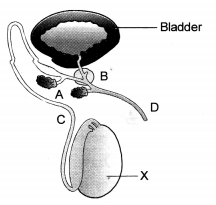
(a) Label A and B
(b) Name the hormone produced by X. What is the role of this hormone in human male ?
(c) Mention the name of substances that are transported by tubes C and D.
(CCE 2011)
Answer:
(a) A —seminal vesicle
B — prostate gland.
(b) X— testosterone. Testosterone controls sperm formation, expression of secondary characters and functioning of accessory glands.
(c) C— sperms.
D — semen (including sperms) and urine.
Question 17.
Differentiate between
(a) Asexual and sexual reproduction
(b) Plumule and radicle
(c) Pollination and fertilization. (CCE 2011)
Answer:
(a) Asexual reproduction is monoparental, with no gametes, no meiosis and very little variations. Sexual reproduction is generally biparental involving fusion of gametes, meiosis and lot of variations.
(b) Plumule is the future shoot while radicle is the future root.
(c) Pollination is the transfer of pollen grains from anther to stigma while fertilization is the fusion of male and female gametes.
Question 18.
(a) Why is vegetative propagation practised for growing some types of plants ?
(b) Name the different parts of a flower that has germ cells.
(c) List any two agents of pollination. (CCE 2011)
Answer:
(a)
- Seedless plants can be propagated only vegetatively, e.g, Banana, Sugarcane,
- Others are propagated vegetatively to obtain flowers and fruits early.
(b) Stamen —Pollen —Male Germ Cells.
Carpel—Ovary — Ovule — Embryo sac — Female Germ Cell.
(c) Wind (anemophily), insects (entomophily).
Question 19.
(a) What is the difference between self and cross pollination ?
(b) What happens to the pollen which falls on a suitable stigma ? Explain. (CCE 2011)
Answer:
(a) Self pollination is transfer of pollen grains from the anther to the stigma of the same flower (e.g., Commeliria, Wheat) while cross pollination is transfer of pollen grains from the anther of one flower to the stigma of another flower of the same species (e.g., Salvia).
(b) After falling on a suitable stigma the pollen absorbs water and nutrients. It produces a pollen tube that grows through the style and reaches the ovary. Its tip contains a tube nucleus and two male gametes. The pollen tube enters an ovule, strikes against one synergid of the embryo sac and bursts open to release its contents. One male gamete fuses with the egg to form zygote while the other fuses with secondary nucleus to produce primary endosperm nucleus.
Question 20.
Name the parts A, B and C and state one function of each part. (CCE 2011, CBSE Delhi 2016)

Answer:
A —anther — formation of pollen.
B—style—lifting stigma to receive pollen.
C—ovary—contains ovules which later develop into seeds while ovary forms the fruit.
Question 21.
State one function each of the following parts of human male reproductive system :
- Vas deferens
- Testis
- Prostate Gland. (CCE 2011)
Answer:
- Vas Deferens: Passage of sperms (hence sperm duct).
- Testis: Produces sperms and male sex hormone called testosterone.
- Prostate Gland: Forms 20-30% of semen, essential for sperm motility.
Question 22.
(a) Name an organism in which binary fission occurs in a definite orientation.
(b) Draw a neat diagram of germinating seed and label on it the following : Cotyledon, Plumule, Radicle. (CCE 2011)
Answer:
(a) LeishmanialEuglena
(b)

Question 23.
(a) Name the parts 1 to 5 of human female reproductive system
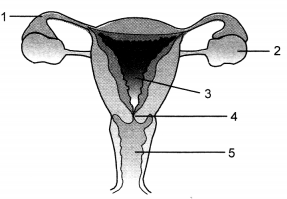
(b) Name the part in which fertilization takes place in the system.
(CCE 2011)
Answer:
(a) 1 — fallopian tube,
2 — ovary,
3 — Uterus,
4 — cervix,
5 — vagina.
(b) Fallopian tube.
Question 24.
(a) How do oral pills function as contraceptives ?
(b) The use of these pills may be harmful. Why ? (CCE 2011)
Answer:
(a) Oral pills prevent ovulation as they contain progesterone with or without estrogen.
(b) Use of oral pills may cause some side effects because they do change the hormonal balance of the body.
Question 25.
(a) Draw a neat diagram of female reproductive system in human beings and label on it :
- The part which secretes ova
- The part where implantation takes place.
(b) What happens if fallopian tube is blocked ? (CCE 2011)
Answer:
(a)
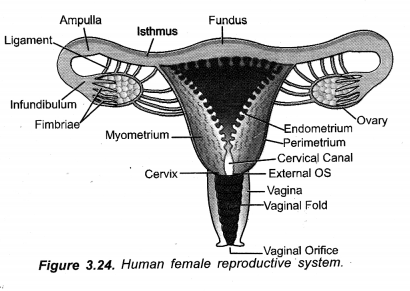
Label
- Ovary (Produces ova)
- Uterus (implantation).
(b) Blockage of fallopian tube will prevent fertilization.
Question 26.
State in brief the function of the following organs in the human female reproductive system,
(a) Ovary
(b) Fallopian tube
(c) Uterus. (CCE 2011)
Answer:
(a) Ovary: Formation of ova and secretion of hormones, estrogen and progesterone.
(b) Fallopian Tube: Passage of ovum, site for fertilization.
(c) Uterus: Implantation and nourishment of embryo.
Question 27.
(a) Name a unisexual flower,
(b) Name the organ known as “birth canal” in female reproductive system.
(c) Mention two factors that determine the size of population. (CCE 2011)
Answer:
(a) Papaya, Watermelon,
(b) Vagina
(c) Birth rate or natality and death rate or mortality.
Question 28.
Draw a neat diagram of germination of pollen on stigma. Also label on it the following parts :
- Female germ cell
- Pollen tube
- Pollen grain
- Male germ cell. (CCE 2011, 2012)
Answer:
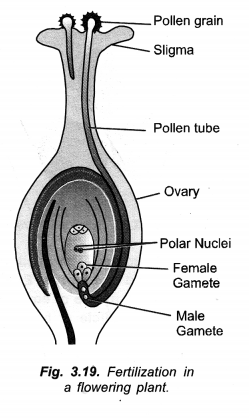
Question 29.
Explain the following methods of contraception giving one example of each
- Barrier method
- Hormonal imbalance method
- Surgical method. (CCE 2011)
Answer:
- Barrier Method. Mechanical Barrier Methods. They prevent passage of sperms into genital tract of the female.
- It is tubular latex sheath to be worp over male copulatory organ during sex.
- Cervical Cap. It is a rubber nipple to be fitted over cervix,
- Contraceptive Diaphragm. It is tubular sheath that is fitted in vagina during sex.
- Hormonal Imbalance Method. It is commonly carried out by the ladies through regular use of oral pills. They inhibit ovulation through suppression of FSH.
- Surgical Method. It is of two types :
- Vasectomy. The two vasa deferentia of the male are blocked by cutting and tying.
- Tubectomy. The two fallopian tubes of the female are blocked by cutting and tying or ligating.
Question 30.
Expand AIDS. List any four methods of prevention (control) of AIDS. (CCE 2011)
Answer:
AIDS—Acquired Immune Deficiency Syndrome.
Methods of Prevention
- Avoiding unprotected sex.
- Use of disposable syringes and needles
- Use of disposable blades and razors,
- Compulsorily complete sterilization of all equipment used in dental treatment and surgery.
- Proper screening of blood before transfusion.
Question 31.
(a) Name any sexually transmitted disease which is
- caused by virus
- caused by bacteria.
(b) What may be the possible reasons for adopting contraceptives for sex ? Mention any two. (CCE 2012)
Answer:
(a)
- Bacterial STD: Gonorrhoea by Neisseria gonorrhoeae
- Viral STD: Genital warts by Human Papilbma Virus,
(b) Reason: Preventing pregnancy for
- Limiting size of family,
- Spacing birth of children so as to provide proper care to each child. .
Methods:
- Barrier method like condom and diaphragm
- Intrauterine device like copper-T
- Oral pills.
Question 32.
State in brief the role of human male reproductive system. Why is it called the urinogenital system ?
(CCE 2012)
Answer:
Role:
- Human male reproductive system synthesises sperms in seminiferous tubules of testes. The testes lie in a pouch of skin or scrotum outside the abdomen to provide 1°-3°C temperature lower than that of body.
- Leydig cells present in the connective tissue of testes secrete male sex hormone or testosterone for maintaining the secondary male sex traits,
- The sperms are stored in epididymes and passed out at the time of ejaculation when secretions from seminal vesicles, prostate gland and Cowper’s glands mix with them to form semen. Urinogenital System. The passage way of male reproductive system is common with the passage of urine from the body. Therefore, male reproductive system is also called urinogenital system.
Question 33.
(a) Explain the process of budding,
(b) Show in sequence the process of budding in Hydra with the help of diagram. (CCE 2012, 2013)
Answer:
(a) Budding is the formation of an outgrowth from an organism which grows and separates to form a new individual. It is a mode of asexual reproduction in both unicellular (e.g., Yeast) and multicellular (e.g., Hydra) organisms.
(b) Budding in Hydra. Some reserve cells present in the lower half of Hydra begin to divide due to some
internal or external stimulus. They form a cellular mound which grows into a bud. Soon the bud develops a mouth and tentacles. It makes the bud nutritionally independent. The bud constricts from base and separates as a new individual.

Question 34.
Give a reason for each of the following :
(a) Regeneration is not considered a method of reproduction.
(b) Blocking of the fallopian tube causes birth control,
(c) Spores generally have a thick wall. (CCE 2012)
Answer:
(a) Regeneration is not the same as reproduction as no propagule is formed and no organism will depend on being cut to be able to reproduce.
(b) Blocking of fallopian tubes will not allow the sperms to reach the ovum.
(c) Spores are a means of dispersal as well as perennation. They have to be thick-walled to tolerate adverse environmental conditions.
Question 35.
(a) Draw a neat labelled diagram of a germinated seed and label radicle, plumule and cotyledon.
(b) Mention function of each of these parts. (CCE 2012)
Answer:
(a)
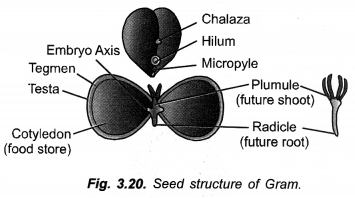
(b)
- Radicle: It forms the first root of the seedling,
- Plumule: It grows to form the shoot of the seedling,
- Cotyledon: It stores food and supplies the same to embryo axis for its growth.
Question 36.
(a) Differentiate between binary and multiple fission. Name an organism that reproduces by multiple fission.
(b) Vegetative reproduction is beneficial to plants that are propagated asexually. Give two advantages.
(CCE 2012)
Answer:
(a) In binary fission a unicellular organism divides into two equal daughters. In multiple fission it gives rise to several (more than 2) individuals. Some residue may be left in multiple fission while no such wastage occurs in binary fission.
Multiple fission occurs in Plasmodium (Malaria Parasite).
(b) Vegetative Reproduction,
- It is the only known method of multiplication in seedless plants like Banana and Sugarcane,
- It is quicker method of multiplication with a crop of uniform yield.
Question 37.
(a) Name any two plants that reproduce through grafting.
(b) List any two benefits to an organism that reproduces through spores. (CCE 2012)
Answer:
(a) Grafting. It is performed in case of high quality Apple, Mango, Pear and some other plants.
(b) Benefits of Spore Formation,
- Spores are a means of dispersal.
- They are often thick-walled and take part in perennation.
- A large number of spores are often formed at one time so that rapid multiplication can occur.
Question 38.
List any four methods of contraception used by humans. How does their use have a direct effect on health and prosperity of the family ? (CCE 2013, 2014)
Answer:
Methods of Contraception:
- Mechanical Barriers like condoms, cervical cap, diaphragm.
- Oral Contraceptives or oral pills like Mala D, Saheli
- Intrauterine Contraceptive Devices (IUCD) like loop, bow, Cu-T.
- Surgical Methods like vasectomy in males and tubectomy in females.
Effects:
- Enjoying a good reproductive health.
- Protecting from sexually transmitted diseases.
- Restricting the number of children.
- Spacing the birth of children so as to properly look after them, provide them proper education without depleting the resources of the family.
- Controlling population.
Question 39.
(a) Explain the process of regeneration in Planaria. (CCE 2014)
(b) How is regeneration different from reproduction ? (CCE 2013, 2014)
Answer:
(a) Regeneration in Planaria. In Planaria, a broken piece of the body grows the missing parts and forms the complete animal. This occurs with the help of reserve or stem cells and dedifferentiation of differentiated cells. They proliferate to form mass of cells which differentiate into various types of cells and tissues just like development in the young animal.

(b) Reproduction is the formation of new individuals by the grown up organisms with the help of propagules or germ cells. Regeneration is growth of injured parts of the individuals for repair and replacement of lost parts.
Question 40.
Write two examples each of sexually transmitted diseases caused by
- virus
- bacteria.
Explain how the transmission of such diseases be prevented ? (CCE 2013)
Answer:
- Viral STDs. Genital warts by human papilloma virus (HPV), AIDS by human immunodeficiency virus (HIV).
- Bacterial STDs. Gonorrhoea by Neisseria gonorrhoeae, Syphilis by Treponema pallidum.
Question 41.
Prevention. Sexually transmitted diseases can be prevented by use of mechanical barriers, especially condoms.
(a) Name the following :
- Thread like non-reproductive structures present in Rhizopus.
- Blobs, that develop at the tip of the non-reproductive threads in Rhizopus.
(b) Explain the structure and function of structures released from the blobs in Rhizopus. (CCE 2013)
Answer:
(a)
- Hyphae (singular hypha).
- Sporangia (singular sporangium).
(b) The structures released by blobs or sporangia are spores. Spores of Rhizopus are thick walled dark coloured and multinucleate. They are dispersed by air. After falling on a suitable substratum, each spore gives rise to a new mycelium.
Question 42.
(a) Define pollination. Why is it necessary for reproduction in flower bearing plants ?
(b) Write one reason to explain why cross pollination is preferred over self pollination ? (CCE 2013)
Answer:
(a) Pollination is the transfer of pollen grains from anther to the stigma. It is essential because the male gametes of flower bearing plants are nonmotile. On stigma a pollen grain germinates and sends male gametes to embryo sac by means of a pollen tube.
(b) Cross pollination produces variations and maintains vigour of the plants.
Question 43.
What are the advantages of sexual reproduction over asexual reproduction ? (CCE 2013)
Answer:
“significance of Sexual Reproduction”
- Due to reshuffling of chromosomes and crossing over, sexual reproduction brings about variations in almost all characters so that no two individuals are similar. Variations are essential for recognition, individuality and competitiveness. They may not protect individuals under adverse conditions but survival of species depends upon pre-adaptive variations.
- Better Adaptability. Increased variability due to sexual reproduction is helpful to organisms in better adaptability to changes in environment.
- Vigour and Vitality. It maintains the vigour and vitality of the individuals.
- Harmful Traits. Harmful traits are often kept suppressed because of reshuffling of gene pairs that occurs during gamete formation and fusion.
- Near Uniformity of Population. Due to the flow of genes amongst individuals during sexual reproduction, the uniformity of population is maintained where there is a broad resemblance of all the individuals with one another.
- Genetic changes brought about by sexual reproduction play an important part in evolution of new forms.
Question 44.
Draw diagrams to explain the regeneration that takes place in each of the body parts of Planaria when its body is cut into three pieces. Name any other organism in which a similar process can be observed.
(CCE 2014)
Answer:
(a)
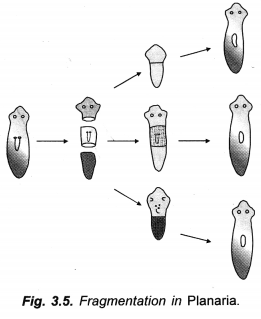
(b) Hydra.
Question 45.
On cutting the body of an organism into many pieces, it was observed that many of these pieces developed as new individuals. Name the process and list two organisms in which this process may be observed. Draw a schematic diagram to illustrate the changes that are likely to be observed during the development of new individuals in any one of the organisms named. , (CCE 2014)
Answer:
(i) Regeneration,
(ii) Planaria, Hydra.

Question 46.
Write one difference between asexual and sexual modes of reproduction. Which species is likely to have better chances of survival, the one reproducing asexually or the one reproducing sexually ? Justify your answer.
(CCE 2014)
Answer:
(a) Difference: Asexual reproduction is monoparental, with no gametes, no meiosis and very little variations. Sexual reproduction is generally biparental involving fusion of gametes, meiosis and lot of variations.
(b) Better Chances of Survival. Sexually reproducing.
Reason:
- Due to reshuffling of chromosomes and crossing over, sexual reproduction produces variations in alomost all characters,
- Sexual reproduction maintains as well as improves vigour and vitality of the individuals,
- Variability and vitality are helpful to organisms in better adaptability to environment.
Question 47.
What is the effect of DNA copying which is not perfectly accurate on the reproductive process ? How does the amount of DNA remain constant though each new generation is a combination of DNA copies of two individuals? (CCE 2014)
Answer:
(a) Inaccuracy in DNA Copying . Even small errors of DNA copying produce variations or mutations. Some of these mutations may be drastic as to kill the cells and stop the reproductive process. Others are minor and form the basis of varied traits.
(b) DNA Amount: The parents are diploid (2n) as each of them has two sets of chromosomes (DNAs). They form haploid (In) male and female gametes through the process of meiosis. The haploid gametes have one set of chromosomes (DNAs). During fertilization, one male gamete fuses with one female gamete. It restores the diploid (2n) chromosome/DNA number in the offspring that is formed from fusion product or zygote (2n).
Question 48.
(a) How would you relate the following methods to asexual reproduction :
- Binary fission
- Spore formation ?
(b) State any advantage of using sexual reproduction over asexual reproduction. (CCE 2014)
Answer:
(a) Asexual reproduction is the formation of new individuals from a part of a single parent without formation and fusion of gametes.
- In binary fission a fully grown unicellular individual divides into two similar individuals or daughters directly.
- In spore formation a single cell or sac of the parent produces a number of reproductive bodies which get dispersed and form new individuals on germination. There is no meiosis or gamete formation in both the cases.
(b) Advantage of Sexual Reproduction. Sexual reproduction introduces variations and maintains the vigour and vitality of the individuals.
Question 49.
Name the type of asexual reproduction demonstrated by the following organisms :
(a) Amoeba
(b) Rhizopus
(c) Planaria
(d) Plasmodium
(e) Spirogyra
(f) Bryophyllum. (CCE 2014)
Answer:
(a) Amoeba. Binary fission.
(b) Rhizopus. Spore formation or sporulation
(c) Planaria. Regeneration
(d) Plasmodium. Multiple fission,
(e) Spirogyra. Fragmentation
(f) Bryophyllum. Vegetative reproduction by foliar buds.
Question 50.
List six specific characteristics of sexual reproduction. (CCE 2015)
Answer:
- Biparental
- Meiosis
- Haploid gametes
- Fertilization
- Diploid zygote
- Variations.
Question 51.
What are chromosomes ? Explain how in sexually reproducing organisms the number of chromosomes in the progeny is maintained. (CCE 2015)
Chromosomes are linear strands of DNA and associated proteins that occur in nucleus of eukaryotic cells, carry genes and function in transmission of hereditary information. (CCE 2015)
Answer:
The parents are diploid (2n) as each of them has two sets of chromosomes (DNAs). They form haploid (In) male and female gametes through the process of meiosis. The haploid gametes have one set of chromosomes (DNAs). During fertilization, one male gamete fuses with one female gamete. It restores the diploid (2n) chromosome/DNA number in the offspring that is formed from fusion product or zygote (2n).
Question 52.
List four points of significance of reproductive health in a society. Name any two areas related to reproductive health which have improved over past 50 years in our country.
Answer:
- People can lead a safe, responsible and satisfying reproductive life.
- Provides protection from catching STDs.
- Advantage of small family, care of the children as well as their proper upbringing
- Less mortality among the new borns.
- Maintenance of proper health of the mother and lesser chances of maternal mortality.
Improvement :
- Reduction in the rate of population growth.
- Decrease in the spread of STDs.
- Adoption of small family norm.
Question 53.
Explain how surgical methods used for men and women respectively help in contraception.
Answer:
Reversible Sterilisation: It is surgical technique that prevents passage of sperms in males and ova in females. The technique is called reversible because by another surgical procedure the passage-way can be restored. Reversible sterilisation is otherwise permanent method of contraception. It is of two types, vasectomy in males and tubectomy in females.
- Vasectomy: The two vasa deferentia of the male are blocked by cutting a small piece and tying the rest. This prevents passage of sperms from testes into semen.
- Tubectomy: A portion of both the fallopian tubes is excised or ligated to block the passage of ovum.
Question 54.
(a) Define germination.
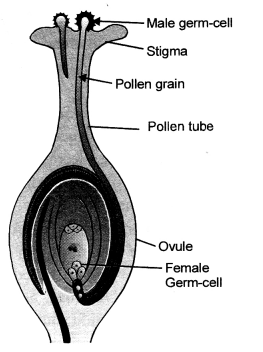
(b) From the given diagram identify the incorrectly labelled parts.
(CCE 2015)
Answer:
(a) Germination. Beginning of growth or sprouting of a propagule like spore, seed or bud is called germination. It requires a particular set of external and internal conditions.
(b) Incorrectly Labelled Parts :
- Male germ cell
- Pollen grain
- Pollen tube
- Ovule.
Question 55.
Give reason as to why the following processes are different from each other,
(a) Fission in Amoeba and Plasmodium.
(b) Regeneration and fragmentation.
(c) Binary fission and fragmentation. (CCE 2015)
Answer:
(a) Under favourable conditions Amoeba multiplies by binary fission while Plasmodium multiplies by multiple fission.
(b)
Regeneration | Fragmentation |
| 1. Process. It is the ability to repair injured parts and grow lost parts. 2. Cells. Ability of regeneration depends upon the occurrence of stem cells and dedifferentiated cells. 3. Occurrence. It occurs in more advanced organisms. | It is breaking up the body of an organism into two or more functional parts. The cells of the fragments possess the ability to divide and bring about growth of the fragments. It occurs in organisms having simple structure. |
(c)
Fission | Fragmentation |
| 1. Organisms. It occurs in unicellular organisms. 2. Nucleocytoplasmic Division. It occurs prior to fission. 3. Multiplication. It gives rise to new individuals. 4. Products. The daughters formed after fission are equal. Ex. Amoeba | Fragmentation is found in multicellular organisms. Cells grow and divide after fragmentation. Pieces of the parent individual grow to form daughter individuals. The products of fragmentation are generally unequal anc dissimilar. Ex. Spirogyra. |
Question 56.
Budding is type of asexual reproduction used by Hydra.
(a) What is meant by asexual reproduction ? How is it different from sexual reproduction ?
(b) Name any other type of asexual reproduction used by Hydra. Define it.
Answer:
Budding is a mode of asexual reproduction in Hydra as the propagules is a bud or outgrowth of somatic body of the animal.
(a) Asexual reproduction is the formation of new individuals from specialized or unspecialized somatic parts of a single parent.
Difference: Asexual reproduction is monoparental, with no gametes, no meiosis and very little variations. Sexual reproduction is generally biparental involving fusion of gametes, meiosis and lot of variations.
(b) Regeneration: It is the ability of an individual to form lost or broken part, sometimes the entire individual from a piece of the parent body through dedifferentiation of mature cells and activity of reserve cells. The ability to form a new individual from a part of the body is well developed in simple animals like Hydra and Planaria. It is restricted to the formation of only broken parts in complex organisms.
Question 57.
What is the importance of DNA copying during reproduction ? Why are offspring formed by asexual reproduction genetically similar to their parents ? (CCE 2015)
Answer:
Importance of DNA Copying : DNA carries hereditary information not only for controlling cellular functions but also all the structural and functional traits of organism. It is because of the latter that single celled zygote is able to form the whole multicellular organism. During reproduction there is formation of new cells which must carry the same amount and type of hereditary information as present in the parent cell. This is accomplished by DNA copying, which occurs prior to each cell division. DNA copying is not error proof. Errors give rise to variations.
Offspring formed by Asexual Reproduction. Asexual reproduction is uniparental. The genetic material present in the offspring is unaltered copy of DNA present in the parent. Therefore, they are genetically similar to the parents.
Question 58.
(a) A women had undergone surgical method for preventing unwanted pregnancies. Does this protect her from getting sexually transmitted diseases ?
(b) How can AIDS be prevented ? (CCE 2015)
Answer:
(a) No, it does not prevent the coming together of body fluids during sex.
(b) Prevention of AIDS,
- Use of barrier method of contraception like condom,
- Protection from getting infected, by blood contact like infected needles, syringes or transfusion,
- Proper sterilisation of dental equipment,
- Prevention of sexual contact with AIDS positive persons,
- Prevention of pregnancy by AIDS positive patients.
Question 59.
Rhizopus is an organism which reproduces by spore formation.
(a) What is meant by spore formation ?
(b) What does the reproductive part or blob of Rhizopus contain ?
(c) Why are these structures protected by thick walls ? (CCE 2015, CBSEA.I. 2017)
Answer:
(a) Spore Formation. It is the formation of minute unicellular asexual reproductive dissemules which on germination give rise to new individuals.
(b) Blob or reproductive part of Rhizopus is sporangium. It contains spores.
(c) Thick Walls of Spores. Spores are dispersed by air currents. They have to face dry, hot, cold and other hostile conditions. Thick wall protects the spores from unfavourable environment.
Question 60.
How does the uterus prepare itself and nurture the growing embryo ? What happens when the egg is not fertilized ? (CCE 2015)
Answer:
Preparation: Under the influence of hormones from pituitary and growing Graafian follicle, the endometrium of uterus thickens, develops blood vessels and glands for nourishing the future embryo.
Nutrition for Growing Embryo. The contact region between embryo and endometrium grows into placenta. Placenta helps the embryo in obtaining nourishment (and oxygen) from blood sinuses of the uterus.
When Egg is not Fertilized: Glands present in the mucosa of uterine endometrium begin to degenerate. This sloughs off the endometrial lining, releasing a lot of mucus and blood. It is called menstruation. Menstruation lasts for 3-5 days.
Question 61.
What do the labelled parts in the diagram work for ? (CCE 2015)

Answer:
Plumule: Formation of shoot.
Cotyledon: Storage of food.
Radicle: Formation of root.
Question 62.

Identify from the diagram the type of reproduction used and the organism showing it. (CCE 2015)
Answer:
A — Hydra, budding (asexual reproduction)
B —Amoeba, binary fission (asexual reproduction)
C — Planaria, regeneration (asexual reproduction).
Question 63.
How do organisms whether reproduced asexually or sexually maintain a constant chromosome number through several generations. Explain with the help of suitable example. (CBSE Delhi 2016)
Answer:
Maintenance of Chromosome Number Over Generations.
In asexual reproduction, new individuals or daughters are formed through mitotic divisions, e.g., Amoeba. There is replication of DNA/chromosomes followed by equal distribution of chromosomes among the daughter cells.
In sexual reproduction chromosome number is ^maintained through two processes, gametogenesis and fertilization. Meiosis occurs during gametogenesis. Here, the chromosome number is halved. For example, human beings with 46 chromosomes produce ova with 23 chromosomes and sperms with 23 chomosomes. Fertilization involving fusion of an ovum (23 chromosomes) with a sperm (23 chromosomes) produces a zygote with 46 chromosomes. The young one develops through mitotic divisions of the zygote so that cells of the grown up individual come to have 46 chromosomes.
Question 64.
What are the functions of testis in the human male reproductive system ? Why are these located outside the abdominal cavity ? Which is responsible for bringing about changes in appearance seen in boys at the time of puberty ? (CBSE Delhi 2016)
Answer:
Functions of Testis. Produces sperms and male sex hormone called testosterone.
Location of Testis. Testes are located outside the abdominal cavity (in testicle behind penis) as maturation of sperms requires a temperature lower by 2°C than that of the body.
Puberty Changes in Boys. They are caused by hormone testosterone.
Question 65.
What is multiple fission ? How does it occur in an organism ? Explain, briefly. Name one organism which exhibits this type of reproduction. (CBSE Delhi 2016)
Answer:
Definition: Multiple fission is a mode of asexual reproduction in a unisexual organism where a single parent produces a number of daughter individuals.
Mechanism: The nucleus of the parent cell divides repeatedly to form a number of daughter nuclei. Cytoplasm gathers around each nucleus followed by development of cell membranes to form daughter cells. The parent cell bursts open to release the daughter individuals.
Example Plasmodium (Malarial Parasite).
Question 66.
What happens when
(a) Planaria gets cut into two pieces
(b) A mature Spirogyra filament attains considerable length
(c) On maturation sporangia burst. (CBSE Foreign 2016)
Answer:
(a) Regeneration in Planaria: In Planaria, a broken piece of the body grows the missing parts and forms the complete animal. This occurs with the help of reserve or stem cells and dedifferentiation of differentiated cells. They proliferate to form mass of cells which differentiate into various types of cells and tissues just like development in the young animal.
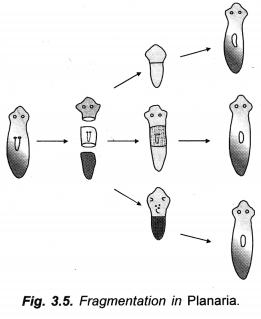
(b) Spirogyra: Multiple fission is better as
- it often occurs inside perennating cysts
- it produces many daughters.
(c) Sporangium: The mature sporangium bursts to expose spores that are picked up by air and dispersed. On settling at suitable medium each spore germinates and forms a new individual.
Question 67.
What is sexual reproduction ? List its four advantages. (CBSE Foreign 2016)
Answer:
Definition: It is a mode of reproduction in which offspring are formed by the process of formation and fusion of gametes.
Advantages:
- It brings traits of the two parents in the offspring.
- It brings about variations due to reshuffling of chromosomes and crossing over.
- It maintains and improves vigour and vitality of the individuals.
- It promotes diversity, adaptations and formation of new species.
Question 68.
Name the reproductive parts of an angiosperm. Where are these parts located ? Explain in brief the structure of its female reproductive part. (CBSE Foreign 2016)
Answer:
- Stamen—male. Carpel-female. They are located in flower.
- The female part or carpel (=pistil) consists of a terminal receptive stigma, a stalk like style and a basal swollen ovary containing ovules. The ovary later matures into fruit while the ovules form seeds.
Question 69.
(a) Mention the role of the following organs of human male reproductive system :
- Testis
- Serotum
- Vas deferens
- Prostate gland.
(b) What are the two roles of testosterone. (CBSE Foreign 2016)
Answer:
(a)
- Testis: Produces sperms and hormone testosterone.
- Scrotum: Holding the two testes outside the abdominal cavity for providing optimum temperature (2°C less than body temperature) for sperm maturation.
- Vas Deferens: Passage of sperms from epididyrryis to ejaculatory duct.
- Prostate Gland: Secretes nutritive fluid for activation of sperms and clotting enzyme for extruded semen.
(b) Testosterone Regulates sperm formation, puberty changes in boys and maintenance of male secondary organs and traits.
Question 70.
Define reproduction. How does it help in providing stability to the population of species ?
(CBSEA.I. 2016)
Answer:
Reproduction is the process of producing new young individuals of similar type by the mature individuals.
Stability: Reproduction maintains the size and composition of population of a species by regularly adding new individuals for replacing the ones getting killed due to ageing, disease or predation. It also adds variations that allow the individuals to adapt to changing environment.
Question 71.
Explain the term “regeneration” as used in relation to reproduction of organisms. Describe briefly how regeneration is carried out in multicellular organisms like Hydra. (CBSE A.I. 2016)
Answer:
Regeneration. It is the ability of an organism to form a complete individual from a piece of the parent body (Regeneration also involves the formation of lost parts by an individual).
Lowly organised multicellular organisms like Hydra have the ability to reproduce through regeneration. For regeneration, the contained stem cells become active. Many differentiated cells undergo dedifferentiation. Both the types of cells proliferate forming a large number of cells. The mass of proliferated cells show differentiation into tissues and organs forming the new individual.
Question 72.
(a) List two reasons for the appearance of variations among the progeny formed by sexual reproduction.
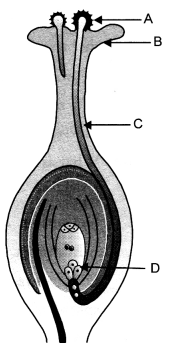
(b)
- Name the part marked ‘A’ in the diagram,
- How does ‘A’ reach part ‘B’ ?
- State the importance of part ‘C’.
- What happens to the part marked ‘D’ after fertilization is over ? (CBSE A.I. 2016)
Answer:
(a)
- Coming together of the chromosomes/traits of the two parents,
- Reshuffling of chromosomes and crossing over.
(b)
- Pollen grain,
- Pollen grains are carried to stigma by the agency of wind, water or insects in the process of pollination,
- It is pollen tube formed on germination of pollen grain. The same carries male gametes to the female gamete,
- In fertilization the egg is converted into zygote which gives rise to embryo.
Question 73.
In context of reproduction of species, state the main difference between fission and fragmentation. Also give one example of each.
Answer:
Fission | Fragmentation |
| 1. Organisms. It occurs in unicellular organisms. 2. Nucleocytoplasmic Division. It occurs prior to fission. 3. Multiplication. It gives rise to new individuals. 4. Products. The daughters formed after fission are equal. Ex. Amoeba | Fragmentation is found in multicellular organisms. Cells grow and divide after fragmentation. Pieces of the parent individual grow to form daughter individuals. The products of fragmentation are generally unequal anc dissimilar. Ex. Spirogyra. |
Question 74.
What happens when
(a) Accidentally, Planaria gets cut into many pieces ?
(b) Bryophyllum leaf falls on the wet soil
(c) On maturation, sporangia of Rhizopus burst.
(CBSE Delhi 2017)
Answer:
(a) Regeneration in Planaria. In Planaria, a broken piece of the body grows the missing parts and forms the complete animal. This occurs with the help of reserve or stem cells and dedifferentiation of differentiated cells. They proliferate to form mass of cells which differentiate into various types of cells and tissues just like development in the young animal.
(b) Leaves of Bryophyllum bear adventitious buds in the marginal notches.
(c) As the leaves fall down on the ground and come in contact with soil, the buds sprout and form new plants.
Question 75.
(a) State the basic requirement for sexual reproduction ?
(b) Write the importance of such reproduction in nature. (CBSE Dlehi 2017)
Answer:
(a) Basic Requirement :
- Meiosis and formation of male and female gametes,
- Fusion of the two types of gametes and formation of diploid zygote.
(b) Importance: It introduces variations or new characters that provide adaptability and increased fitness due to
- Chance separation of chromosomes during meiosis required for gamete formation,
- Crossing over during meiosis.
- Chance coming together of chromosomes during fertilization,
- Mutations or mistakes during DNA replication.
Question 76.
State the changes that take place in the uterus when
(a) Implantation of embryo has occurred
(b) Female gamete/egg is not fertilised. (CBSE Delhi 2017)
Answer:
(a) Implantation of Embryo has Occurred: Endometrium thickens, becomes glandular and highly vascular. The contact region between embryo and uterine wall grows into placenta. Placenta helps the embryo in obtaining nourishment and oxygen from blood sinuses of the uterus. It also helps in transfer of wastes from embryo to the blood of the mother.
(b) Female Gamete is not fertilized: Glands present in the mucosa of uterine endometrium begin to degenerate. This sloughs off the endometrial lining, releasing a lot of mucus and blood. It is called menstruation. Menstruation lasts for 3-5 days.
Question 77.
Mention the total number of chromosomes alongwith the sex chromosomes that are present in a human female and a human male. Expain how in sexually reproducing organisms the number of chromosomes in the progeny remains the same as that of the parents. (CBSE Delhi 2017)
Answer:
(a) Chromosome Number. Human Female— 44 autosomes + XX sex chromosomes or allosomes.
Human Male. 44 autosomes + XY allosomes.
(b) Same Chromosome Number: The parents are diploid (2n) as each of them has two sets of chromosomes (DNAs). They form haploid (In) male and female gametes through the process of meiosis. The haploid gametes have one set of chromosomes (DNAs). During fertilization, one male gamete fuses with one female gamete. It restores the diploid (2n) chromosome/DNA number in the offspring that is formed from fusion product or zygote (2n).
Question 78.
List any four steps involved in sexual reproduction and write its two advantages. (CBSE Delhi 2017)
Answer:
Steps:
- Formation of male and female gametes through meiosis
- Transfer of male gamete to the area of female gamete.
- Fusion of the two types of gametes resulting in the formation of diploid zygote.
- Development of zygote into embryo that grows into a new individual.
Advantages:
- Variations. Due to reshuffling of chromosomes and crossing over, variations appear in almost all characters,
- Adaptability and Evolution. Variations help the organisms to develop adaptability to changes in environment. Their accumulation can also lead to formation of new species.
Question 79.
Reproduction is one of the most important characteristics of living beings. Give three reasons in support of the statement. (CBSE A.I. 2017)
Answer:
Reproduction is essential for
- Perpetuation or continuation of species
- Replacement of dead individuals and maintaining the organisation in population.
- Introduction of variations for better adaptability and survival.
Question 80.
What is vegetative propagation ? State two advantages and two disadvantages of this method.
(CBSE A.I. 2017)
Answer:
Definition: Vegetative propagation is the formation of new plants by using vegetative parts of a parent plant as propagules e.g., stem (Sugarcane, Bougainvillea, Potato), root (Sweet Potato, Dahlia), leaf (Bryophyllum), bud (Agave).
Advantages:
- It is the only known method of multiplication of seedless plants like Banana and Sugarcane.
- It is a quicker method as vegetatively reproduced plants bear flowers and fruits earlier than plants raised through seeds.
- All the individual plants are clones of one another and their parent so that the crop is genetically uniform.
- Good quality of a variety can be maintained indefinitely.
Disadvantages:
- There is little adaptability to changes in envrionment.
- Diseases contracted by a parent spread to all the daughters.
Question 81.
List three techniques that have been developed to prevent pregnancy. Which one of these techniques is not meant for males ? How does the use of these techniques have a direct impact on the health and prosperity of a family. (CBSE A.I. 2017)
Answer:
(a) Contraceptive Techniques: Barrier methods, Hormonal methods, Surgical methods.
(b) Not Meant for Males. Hormonal methods.
(c) Impact.
- Enjoying a good reproductive health.
- Protecting from sexually transmitted diseases.
- Restricting the number of children.
- Spacing the birth of children so as to properly look after them, provide them proper education without depleting the resources of the family.
- Controlling population.
Question 82.
How do variations arise in organisms ? “Variation is useful for survival of species”, justify this statement with the help of an example. )CBSE Foreign 2017)
Answer:
(a) Variations. Variations are differences found in morphological, physiological and other traits of individuals
belonging to the same organism, race or family. They develop due to
- Faulty DNA replication
- Crossing over
- Chance separation of chromosomes during meiosis and chance combination during fertilization.
(b) Variation for Survival. Some of the variations function as pre-adaptations. They help in survival under adverse conditions. Rise in temperature of temperate waters would kill all bacteria except some which had a variation to tolerate heat. Such bacteria will survive and multiply.
Question 83.
What is regeneration ? Give on example of an organism that shows this process and one organism that does not. Why does regeneration not occur in the latter ? (CBSE Foreign 2017)
Answer:
Regeneration: It is ability of an individual to form lost or broken parts, sometimes the entire individual I from a piece of the parent body. The ability to form the whole individual from a piece of parent body is
found only in simple animals like Hydra and Planaria. It does not occur in complex organisms like humans, birds, lizards etc. Here regeneration is limited to repair or regeneration of minor parts. It is because the tissues and organs are highly differentiated in complex animals.
Examples: Planaria, Hydra. Organisms Not Showing Regeneration. Amoeba, Rhizopus, Banana. The reason for absence of regeneration is non-availability of reserve cells and incapability of differentiated cells to dedifferentiate.
Question 84.
What is contraception ? Name any two methods. How does the use of these methods have a direct effect on the health and prosperity of a family ? State any three points. (CBSE Foreign 2017)
Answer:
Contraception. It is technique or mechanism to deliberately prevent conception or impregnation or pregnancy.
Techniques. Barrier methods, Hormonal methods, Surgical methods.
Impact:
- Enjoying a good reproductive health.
- Protecting from sexually transmitted diseases.
- Restricting the number of children.
- Spacing the birth of children so as to properly look after them, provide them proper education without depleting the resources of the family.
- Controlling population.
Question 85.
What is placenta ? Describe its two major functions. (CBSE Foreign 2017)
Answer:
Placenta: It is a special double layered, spongy tissue connection between the foetus and uternine wall found in pregnant females. It has finger-like outgrowths or villi which are in contact with blood sinuses present in the uterine wall.
Role:
- Attachment: Placenta attaches the foetus to uterine wall.
- Villi: Placenta has finger-like outgrowths or villi which develop a large surface area for fixation and absorption.
- Nutrients: Placenta picks up nutrients from mother’s blood and passes it to the blood of the foetus.
- Waste Products: Waste products produced by the foetus passes out through the placenta into mother’s blood.
- Gases: Foetus obtains oxygen supply from mother’s blood and eliminates carbon dioxide through placenta.
Question 86.
Name the two types of mammalian gametes. How are they different from each other. Name the type of resproduction they are involved in. Write the advantage of this type of reproduction. (CBSE Foreign 2017)
Answer:
Mammalian Gametes. Male-Sperm, Female-Ovum.
Differences: Male gamete or sperm is smaller, dart-like motile gamete with scanty amount of food reserve. Female gamete or ovum is larger, rounded, non-motile gamete with a good amount of reserve food. The difference helps the ovum to get loaded with cytoplasmic contents and allow the sperm to swim freely upto the ovum.
Advantages:
- Variations. Due to reshuffling of chromosomes and crossing over, variations appear in almost all characters,
- Adaptability and Evolution. Variations help the organisms to develop adaptability to changes in environment. Their accumulation can also lead to formation of new species.
Long Answer Questions (5 Marks Each)
Question 1.
Draw the diagram of a flower to show its male and female reproductive parts. Label the following in it ;
- Ovary
- Anther
- Filament
- Stigma.
What is the function of anther ? How does fusion of male and female gametes take place in plants ?
Answer:
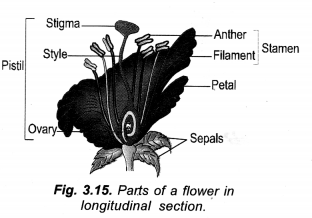
Function of Anther. To produce haploid pollen grains which on growth form pollen tubes, each containing two male gametes.
Fusion of Male and Female Gametes. On germination over stigma, a pollen grain forms a long pollen tube carrying two male gametes. Pollen tube enters an ovule and bursts open in the embryo sac. One male gamete fuses with the egg to form diploid zygote. It is generative fertilization. The second male gamete fuses with diploid secondary nucleus of central cell to form triploid primary endosperm cell. It is vegetative fertilization. The phenomenon of two male gametes fusing with different cells in the same embryo sac to produce two different structures is called double fertilization.
Question 2.
(a) Draw a diagram showing germination of pollen on stigma of a flower.
(b) Label pollen grain, male germ cells, pollen tube, stigma, ovary and female germ cell in the above diagram.
(c) How is zygote formed ? (CBSE Delhi 2008 Ç, CCE 2012)
Answer:
(d)
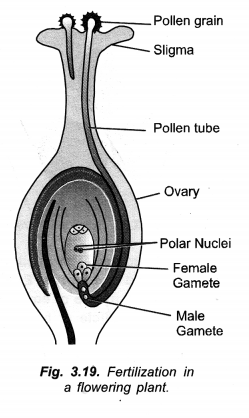
(b) Label as required.
(c) Zygote or first diploid cell is formed by fusion of a male gamete (brought by pollen tube) with oosphere or egg inside the embryo sac.
Question 3.
Draw a longitudinal section of a flower and label the following parts :
- Part that produces pollen grains,
- Part that transfers male gametes to the female gametes.
- Part that is sticky to trap pollen grain,
- Part that develops into a fruit. (CBSE A.I. 2010)
Answer:
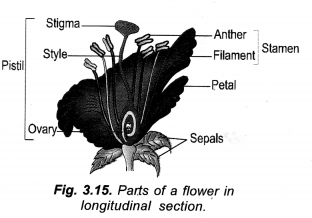
Labelling,
- Anther—part that produces pollen grains.
- Style—part that transfers male gametes to female gametes, by providing growth medium to pollen tubes.
- Stigma—part that is sticky to trap pollen grain.
- Ovary—part that develops into a fruit.
Question 4.
(a) Explain the role of placenta in the development of human embryo.
(b) Give example of two bacterial and two viral sexually transmitted diseases. Name the most effective contraceptive which prevents spread of such diseases. (CBSE A.I. 2010, CCE 2015)
Answer:
(a) Role of Placenta:
- Attachment: Placenta attaches the foetus to uterine wall.
- Villi: Placenta has finger-like outgrowths or villi which develop a large surface area for fixation and absorption.
- Nutrients: Placenta picks up nutrients from mother’s blood and passes it to the blood of the foetus.
- Waste Products: Waste products produced by the foetus passes out through the placenta into mother’s blood.
- Gases: Foetus obtains oxygen supply from mother’s blood and eliminates carbon dioxide through placenta.
(b) Bacterial STDs:
- Gonorrhoea caused by Neisseria gonorrhoea.
- Syphilis caused by Treponema pallidum.
Viral STDs:
- Genital warts by Human Papilloma Virus (HPV).
- AIDS caused by Human Immunodeficiency Virus (HIV).
Effective Contraceptive. Condom (mechanical barrier).
Question 5.
(a) Differentiate between germination and fertilization.
(b) Differentiate between pollen and ovule
(c) What happens to the following parts after fertilization
- Ovum
- Ovary
- Ovule
- Sepals and petals.
(CCE 2011)
Answer:
(a) Germination is the growth of contents of a propagule as the formation of seedling from a seed. Fertilization is fusion of haploid male and female gametes to produce a diploid zygote.
(b) Pollen grain is a haploid structure that grows to form male gametophyte having two male gametes in plants. Ovule is diploid structure in which haploid megaspore produces the female gometophyte or embryo sac having a single female gamete or oosphere.
(c) After fertilization :
- Ovum forms zygote from which embryo develops,
- Ovary forms fruit.
- Ovule produces seed,
- Sepals and petals shrivel and fall off. In some sepals may persist.
Question 6.
(a) Draw a neat diagram of the reproductive system of a human female and label the following :
- Reproductive part that produces female hormone,
- Site of fertilization.
- Organ where growth and development of the embryo takes place,
- Entry of sperms.
(b) How does the growing embryo meet with its nutritional requirements ?
(c) What happens if the ovum is not fertilized ?
(d) Mention a contraceptive method that can be used by the human female. (CCE 2011, 2012)
Answer:
(a)
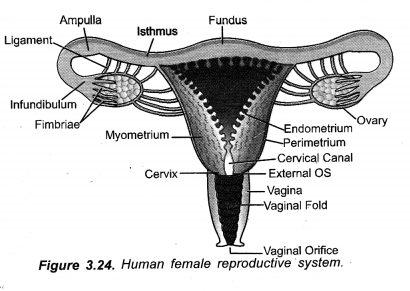
- Ovary
- Fallopian tube
- Uterus
- Vagina.
(b) Growing embryo obtains nourishment from uterus with the help of a special structure called placenta.
(c) Non-fertilization of ovum later leads to sloughing off the glandular part of the uterine wall and coming out of vagina with blood and mucus collectively called menstrual fluid.
(d) Oral pill/ diaphragm.
Question 7.
(a) Give the function of
- Stigma
- Pollen tube,
(b) List two changes observed in the body of a female during puberty,
(c) State in brief the formation of seed in a flower. (CCE 2011)
Answer:
(a)
- Stigma. Reception of pollen grains and providing nutrients to pollen grains for their germination
- Pollen Tube. Carrying of male gametes to inside the ovule for fertilization.
(b)
- Increase in size of breasts and darkening of skin at the base of nipples,
- Broadening of pelvis and beginning of menstruation.
(c) In a fertilized ovule, embryo grows till it is fully formed. Food is stored either in embryo or in endosperm. The integument of the ovule gets transformed into impermeable seed coat or testa. This changes the ovule into a seed.
Question 8.
(i)
- Production of sperm
- Gland which provides fluid
- Provides low temperature for formation of sperms
- Common passage for sperms and urine.
(ii) Name a sexually transmitted disease and a method to avoid it.
(iii) State any two changes seen in boys at the time of puberty. (CCE 2011)
Answer:
(i)
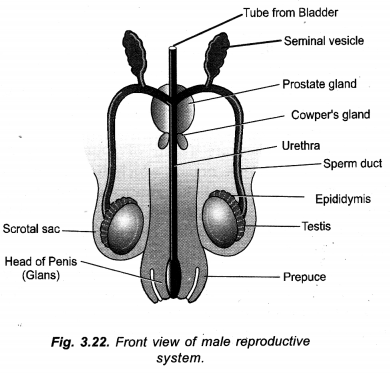

- Testis
- Prostate gland and seminal vesicles,
- Scrotum
- Urethra.
(ii) Gonorrhoea, syphilis (bacterial), warts, HIV (viral). Use of condoms can prevent transmission of infection from infected person to healthy person.
(iii) Development of hair on face, broadening of shoulders and development of larynx with low pitched cracking voice.
Question 9.
(a) Colonies of Yeast fail to multiply in water but multiply in sugar solution. Give one reason for this,
(b) How will an organism he benefitted if it reproduces through spores ?
(c) How is regeneration different from fragmentation ? (CCE 2011)
Answer:
(a) Yeast is heterotrophic. It obtains its nourishment from outside. Plain water cannot provide nourishment to yeast while sugar solution can do so. Therefore, Yeast multiplies in sugar solution and not in plain water.
(b) The parents are diploid (2n) as each of them has two sets of chromosomes (DNAs). They form haploid (In) male and female gametes through the process of meiosis. The haploid gametes have one set of chromosomes (DNAs). During fertilization, one male gamete fuses with one female gamete. It restores the diploid (2n) chromosome/DNA number in the offspring that is formed from fusion product or zygote (2n).
(c) Regeneration is the ability of an individual to form lost or broken part, sometimes the entire individual from a piece of parent body, e.g., Planaria. Fragmentation is the breaking of the individual into two or more pieces, with each piece growing to form the mature individual, e.g, Spirogyra.
Question 10.
(a) State any three advantages of sexual reproduction over asexual reproduction,
(b) Explain what happens to the egg once it gets fertilized in human female. (CCE 2011, 2013)
Answer:
(a) Advantages of Sexual Reproduction,
- Due to reshuffling of chromosomes and crossing over, sexual reproduction produces variations in alomost all characters,
- Sexual reproduction maintains as well as improves vigour and vitality of the individuals,
- Variability and vitality are helpful to organisms in better adaptability to environment.
(b) Fertilized egg undergoes cleavage forming first a morula and then blastocyst. Blastocyst descends into uterus. With the help of villi, it gets implanted in the wall of uterus. The contact region grows into a disc shaped tissue called placenta. Blastocyst undergoes further development and forms foetus. The foetus remains attached to placenta by means of an umbilical cord. Placenta provides attachment and nourishment to foetus. It also takes away waste products of embryo. Total period required by embryonic development is called gestation period. It is 270 days (40 weeks or 280 days from the date of last menstruation) . The fully formed foetus or embryo is delivered. The process is called parturition.
Question 11.
(a) Name a plant in which vegetative propagation takes place by leaves,
(b) Write causal organism of the following diseases : (t) Warts (zz) Syphilis
(c) Name part of female reproductive system which is ligated to avoid fertilization.
(d) Which device prevents implantation by irritating the lining of uterus ?
(e) What could be the possible reason for declining female sex ratio in our country. Suggest two measures to achieve 1 : 1 ratio.
Answer:
(a) Bryophyllum.
(b)
- Warts — Virus (Human Papilloma Virus or HPV).
- Syphilis —Bacterium ( Treponema pallidum).
(c) Fallopian tubes
(d) Intrauterine device like copper-T.
(e)
- Female foeticide
- Measures. (I) Banning prenatal sex test (II) Giving inducement and facilities for the female child.
Question 12.
(a) List any two reasons for the appearance of variations among the progeny formed by sexual reproduction
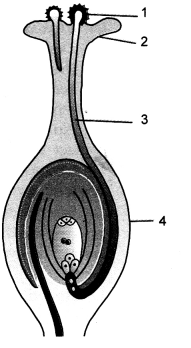
(b)
- Name the parts maked ‘1’ and ‘2’ in the diagram
- How does ‘1’ reach ‘2’ ?
- What happens to part ‘4’ after fertilization ?
- Mention the importance of part 3. (CCE 2011)
Answer:
(a) Variations appear in the progeny of sexually reproducing organisms due to
- Random separation and coming together of chromosomes during gamete formation and gamete fusion
- Crossing over and mutations.
- Coming together of chromosomes of the parents.
(b)
- ‘1’— pollen grain.
‘2’ — stigma, - Through pollination,
- Formation of fruit,
- It takes the male gametes to the inside of ovule.
Question 13.
(a) Draw the diagram of a flower to show its male and female reproductive parts.
Label the following parts on it :
- Ovary
- Anther
- Filament
- Stigma.
(b) How does fusion of male and female gametes takes place in plants ?
(c) List in tabular form any two differences between a male gamete and a female gamete. (CCE 2011)
Answer:
(a)

(b) After passing into ovule, the pollen tube enters the embryo sac through one of the synergids. It then bursts open to release its two pale gametes. One male gamete fuses with the female gamete called oosphere. It gives rise to zygote. Zygote grows to form the embryo.
(c)
| Male Gamete | Female Gamete |
| 1. Size: It is generally smaller. 2. Food: It has little stored food. 3. Motility: The male gamete is generally motile. | 1. Female gamete is generally larger. 2. It contains a lot of stored food. 3. The female gamete is generally non-motile. |
Question 14.
(a) Name the parts A, B, C and D in the diagram

(b) Name the parts associated with
- Fertilization
- Production of an egg.
(c) What happens to the lining of uterus
- Before release of fertilized egg
- If no fertilization occurs,
(d) Name the surgical methods of birth control. (CCE 2011, 2012)
Answer:
(a) (A) — Fallopian tube.
(B) — Ovary.
(C) — Endometrium.
(D) — Cervix.
(b)
- Fertilization— Fallopian tube,
- Production of Egg. Ovary.
(c)
- Proliferation of endometrium under the influence of estrogen and progesterone.
- After a few days, endometrial lining breaks. Alongwith mucus and some blood it is passed out as menstruation.
(d) Vasectomy (blockage of vasa deferentia in males) and tubectomy (blockage of fallopian tubes in females).
Question 15.
(a) Draw a diagram to show fertilization in a flowering plant and label on it
- Stigma
- Ovary
- Pollen grain
- Female germ cell.
(b) Define the term “double fertilization” in plants. After fertilization name the part that develops into
- Fruit
- Seed.
(c) How is the mode of reproduction in unicellular organisms different from multicellular organisms ?
(CCE 2011)
Answer:
(a)

(b) Definition: The phenomenon of two male gametes fusing with different cells in the same embryo sac to produce two different structures is called double fertilization.
One male gamete fuses with oosphere (egg) to form diploid zygote. It is called generative fertilization. Zygote grows to form embryo. The second male gamete fuses with diploid secondary nucleus of central cell. It produces a triploid primary endosperm cell. The fusion is called triple fusion or vegetative fertilization. It produces a nutritive tissue called endosperm.
(c) Unicellular organisms can multiply through cell-by-cell division. This is not possible in case of multicellular organisms. Here, special cells and other complex modes of multiplication are found.
Question 16.
(a) How does Hydra reproduce ? Explain in brief with the help of a labelled diagram.
(b) Is fertilization possible without pollination ?
(c) What is copper-T ? In which part of the reproductive system is it placed ?
(d) Describe changes in a flower after fertilization. (CCE 2011)
Answer:
(a) Under favourable conditions Hydra reproduces by budding. A bud develops in the lower half due to proliferation of cells. The bud grows in size. It develops mouth and tentacles and begins to feed itself. The bud now constricts at the base and separates as a new individual.
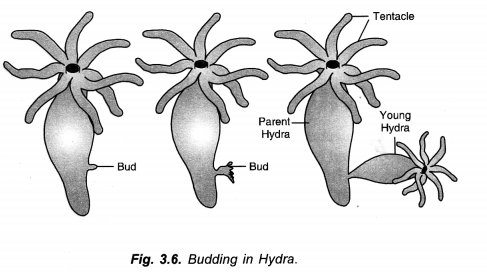
(b) No. Fertilization cannot occur without the male gamete (brought by germinating pollen grain) coming in contact with female gamete.
(c) Copper—T is an intra-uterine device which is kept inside the uterus causing death of sperms and irritation of endometrial lining so as to prevent implantation.
(d) After fertilization, the non-essential and non-required parts of a flower wither and fall down. Petals and stamens are the first to be shed. Sepals may or may not persist. Style and stigma are also shed in most of the cases. The ovary grows in size and ripens into fruit.
Question 17.
(a) The fertilized ovules also grow in size. They ripen into seeds. How does reproduction occur in
- Malaria Parasite
- Leishmania.
(b) Categorise the following flowers into bisexual and unisexual : Papaya, Watermelon, Hibiscus, Mustard.
(c) State in brief the function of urethra in man. (CCE 2011)
Answer:
(a)
- Malaria Parasite: Multiple fission (asexual). Sexual reproduction also occurs,
- Leishmania: Longitudinal binary fission (asexual). Sexual reproduction also’occurs.
(b) Bisexual: Hibiscus, Mustard. Unisexual. Papaya, Watermelon
(c) Urethra: Passage of urine (both in males and females), passage of semen in males.
Question 18.
(a) Draw a well labelled diagram of human male reproductive system,
(b) When does ovulation occur during the menstrual cycle in a normal healthy woman,
(c) What is menopause ? (CCE 2012)
Answer:
(a)
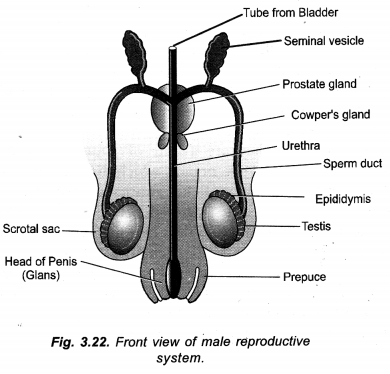
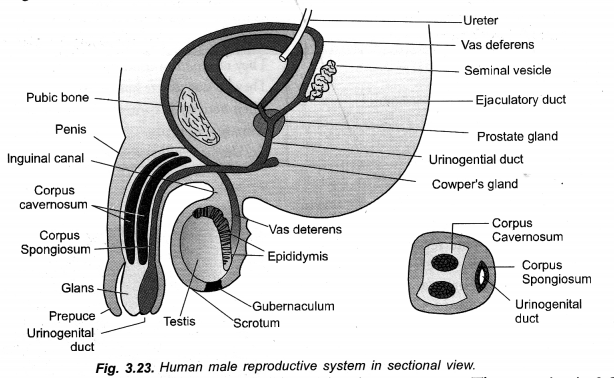
(b) Timing of Ovulation: 13th or 14th day of menstrual cycle.
(c) Menopause: It is permanent stoppage of menstruation in women which generally occurs between the age ‘ of 45—50 years.
Question 19.
(a) What is meant by asexual reproduction ? List four different methods of asexual reproduction.
(£) Describe in brief binary fission in Amoeba. (CCE 2012)
Answer:
(a) Asexual Reproduction. It is mode of reproduction in which a part of a single parent gives rise to a new individual without fertilisation or fusion of gametes.
Methods,
- Fission (binary and multiple)
- Budding.
- Fragmentation,
- Spore formation.
(b) Binary Fission in Amoeba. It can occur in any plane. Pseudopodia are withdrawn. The nucleus elongates and then divides into two. The cytoplasm also cleaves. It produces two daughters, each with a single nucleus.
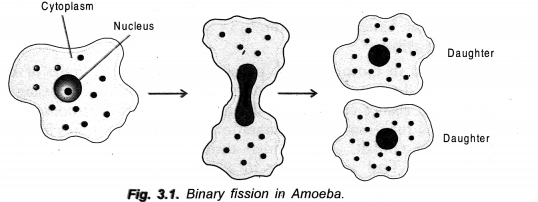
Question 20.
(a) Draw a labelled diagram of human male reproductive system.
(b) Mention the function of testes. Where are they located ? (CCE 2012)
Answer:
(a)
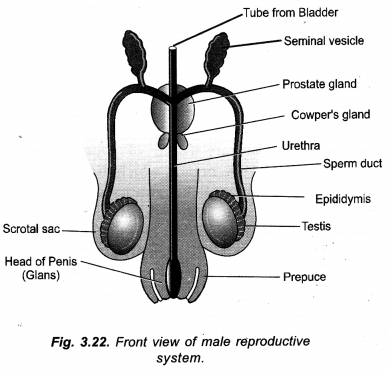
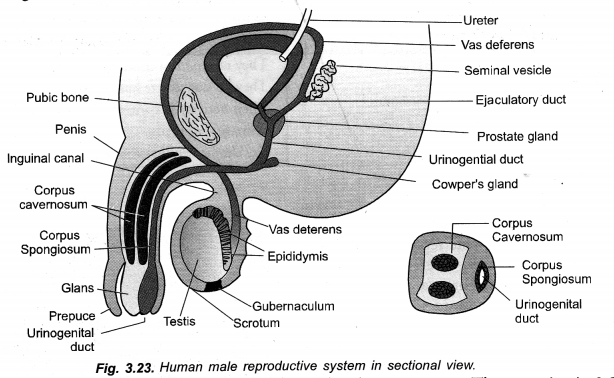
(b) Function of Testes. Formation of sperms and secretion of male sex hormone testosterone.
Location. The two testes lie in the two chambers of scrotum which hangs from the abdomen behind the penis.
Question 21.
(a) How do the following contraceptives prevent pregnancy :
- Oral pills
- Condom.
(b) Mention the possible misuse of surgical method of birth control by some people. How is this method causing harm to the society ? State the steps taken by the government to prevent this misuse. (CCE 2012)
Answer:
(a)
- Oral Pills: They prevent ovulation (release of mature ovum from ovary) as they contain progesterone (with or without estrogen).
- Condom: It is a mechanical method which prevents the entry of sperms in the reproductive tract of the female.
(b) Misuse of Surgical Method. Abortion as a means of termination of unwanted pregnancy has been misused to terminate only female foetus. This has caused a decline in sex ratio which is likely to create social tension. In order to prevent female foeticide, the government has banned prenatal sex determination.
Question 22.
(a) Give an example of a bisexual flower. What is its female reproductive organ known as.
(b) Draw a diagram of its longitudinal section showing the process of germination of pollen on stigma and label the following on it :
- Male germ cell
- Female germ cell
- Ovary
- Pollen tube.
(c) List any two differences between pollination and fertilisation. (CCE 2012)
Answer:
(a) Bisexual Flower. Mustard, Salvia. Female Reproductive Part. Pistil or carpel.
(b)
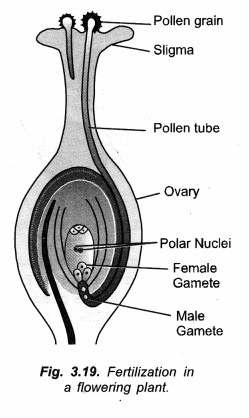
(c)
- Pollination is the transfer of pollen grains from the anthers to the stigma of a flower. Fertilization is the fusion of a male gamete brought by pollen tube with the egg or oosphere of the embryo sac.
- Pollination is the first physical process of sexual reproduction in seed plants. Fertilization is the later biological process of sexual reproduction.
Question 23.
(a) Female and male germ cells are respectively present in ovary and pollen grains of a flowering plant. Draw a labelled diagram to show germination of pollen on stigma.
(b) Explain post fertilization changes that occur in a flower. (CCE 2012)
Answer:
(a)
- Female Germ Cell. Oosphere, present in embryo sac part of ovule.
- Male Germ Cell. Male gamete or sperm formed in germinating pollen grain and taken to embryo sac by pollen tube.

(b) Post Fertilization Changes,
- Zygote forms embryo,
- Primary endosperm cell produces nutritive tissue called endosperm
- Integuments. Form seed coats. Ovule is transformed into seed. Ovary is transformed into fruit.
Sepals, petals and stamens shrivel and fall down. Sepals persist is some plants. Style and stigma also fall down.
Question 24.
(a) Draw diagram of a germinating seed and label
- Part that gives rise to shoot system,
- Part that gives rise to root system,
- Part that contains stored food.
(b) How do Potato and Bryophyllum plants reproduce vegetatively ? (CCE 2012)
Answer:
(a)
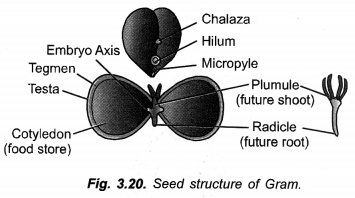
label:
- Plumule
- Radicle
- Cotyledon.
(b)
- Potato is multiplied vegetatively by planting pieces of tubers, containing one or more eyes (depression with buds),
- Bryophyllum is multiplied by placing a mature leaf over moist soil when several plantlets will be formed from growth of buds present in marginal notches.
Question 25.
(a) List the sexually transmitted diseases.
(b) Mention any one method that should be adopted both by male and female for safe sex. (CCE 2012)
Answer:
(a) Gonorrhoea, syphilis, genital warts, AIDS.
(b) Wearing of condoms (males) or contraceptive diaphragms (females) protect both males and females from getting sexually transmitted diseases.
Question 26.
(a) Draw labelled diagram of human male reproductive system.
(b) State the reason why testes are located outside abdominal cavity.
(c) Name the hormone secreted by testes.
(d) Write two glands found in male reproductive pathway and specify their roles. (CCE 2012)
Answer:
(a)
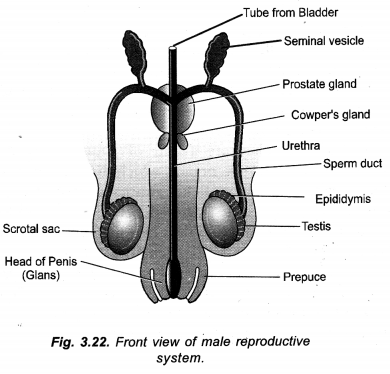
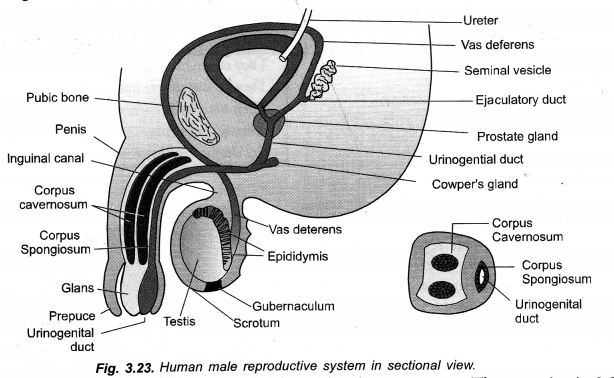
(b)
- Scrotum not only protects the testes but also acts as a thermoregulator by changing position of the testes.
- It keeps the temperature of testes 1 -3° C below that of the body. A lower temperature is essential for development of sperms.
(c) Testosterone:
- Regulating sperm formation,
- Puberty changes in males,
- Maintenance of male secondary organs and traits.
(d) Two Glands: A pair of seminal vesicles and prostate gland.
Seminal Vesicles: They secrete 60-70% of semen plasma that is alkaline and viscous having fructose (for nourishing the sperms), fibrinogen, proteins and prostaglandins. Prostaglandins cause movements in the genital tract of the female. Sperms are also activated by secretion of seminal vesicles.
Prostate Gland: It produces 20-30% of semen plasma. The secretion is alkaline and viscous. It has clotting enzyme and chemical essential for sperm activity.
Question 27.
(a) Draw a neat diagram of human female reproductive system and label
- Oviduct
- Ovary
- Uterus
- Cervix.
(b) Mention the function of uterus and oviduct. (CCE 2012)
Answer:
(a)
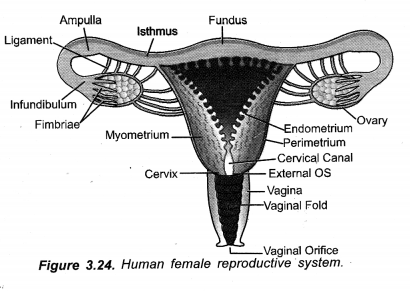
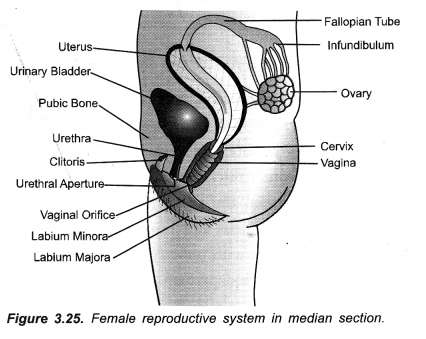
(b)
- Uterus,
- It is seat of implantation of embryo.
- Uterus provides protection to embryo,
- It supplies nutrients to the foetus and takes away its waste products.
- Oviduct (Fallopian Tube),
- It is passageway for ova.
- It is the site of fertilization of ovum.
Question 28.
(a) Give reason :
- Wind acts as a pollinating agent
- Variation is essential and beneficial to a species.
- Use of condoms prevents pregnancy.
(b) What is menstruation ? Explain why it occurs.
How does embryo get nutrition in mother’s womb. (CCE 2012)
Answer:
(a)
- Wind picks up the pollen grains of dehisced anthers and disperses the same. Stigmas are often feathery or sticky to retain pollen grains striking against them. Wind pollination is called anemophily.
- Variations function as preadaptations which help the species to survive in changed environmental conditions.
- Condoms are mechanical barriers which do not allow the sperms to pass into genital tract of the female. Therefore, pregnancy is prevented.
(b) Menstruation:
- It is discharge of blood, mucus and broken pieces of endometrial lining in reproductively active females which occurs for 3-5 days at regular intervals of 28 days (lunar month). It occurs in response to non-fertilization of ovum and non-availability of progesterone hormone.
- Nutrition to Embryo: Embryo gets nourishment from mother’s body with the help of placenta through a cord called umbilical cord. Placenta contains many finger-like villi from the chorion covering of the embryo. They occur in contact with blood sinuses of the mother present in the endometrial lining of uterus. All nutrients (glucose, amino acids, vitamins, etc.) diffuse from mother’s blood into villi and from there to embryo through the umbilical cord.
Question 29.
With the help of suitable diagrams explain how reproduction occurs in Hydra and Planaria. Also name the process involved. (CCE 2012)
Answer:
Reproduction, in Hydra: Some reserve cells present in the lower half of Hydra begin to divide due to some internal or external stimulus. They form a cellular mound which grows into a bud. Soon the bud develops a mouth and tentacles. It makes the bud nutritionally independent. The bud constricts from base and separates as a new individual.
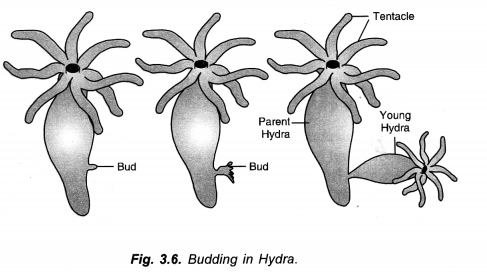
Reproducdon in Planaria. It occurs by regeneration. Due to passage through narrow spaces, Planaria often gets broken into two or more pieces. The cut ends of the pieces show proliferation of cells. The newly formed cells undergo differentiation and form missing parts to regenerate the whole animal.
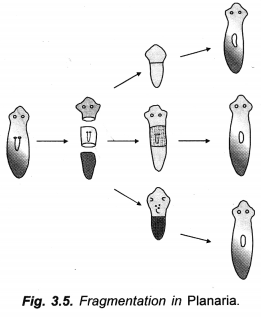
Question 30.
Write two causes of human population explosion. Explain with the help of suitable examples, how this explosion can be checked. (CCE 2013)
Answer:
Population explosion is the rapid rise in human population.
Causes:
- Decrease in death rate,
- Longer life span. Both are due to progressively improving health care facilities.
Check: Population explosion can be checked only through fertility control or family planning.
This can be achieved through
- Education. There is an inverse ratio between education and population growth.
- Population Education. It is imparting knowledge to public about the effects of excessive population, advantages of small families and means to achieve it.
- Marriageable Age. Number of births is reduced if young persons marry late. Gainful employment and higher social status of women also reduce birth rate.
- Easy Availability of Birth Control Means. This will reduce reluctance on the part of eligible couples to adopt family planning measures.
Question 31.
What is pollination ? How does it occur in plants ? How does pollination lead to fertilization ? Explain.
(CCE 2013)
Answer:
Pollination: It is the transfer of pollen grains from anther to the stigma.
Occurrence: Pollination can occur through the agency of air (anemophily), water (hydrophily), insects (entomophily) as well as other animals and mechanical disturbance (self pollination).
Fertilization: After falling on a compatible stigma, the pollen grain absorbs water and nutrients. It gives out pollen tube. The pollen tube carries two male gametes. It grows through style, reaches ovary, enters an ovule and bursts open into its embryo sac. One male gamete fuses with the egg to produce diploid zygote. It is fertilization. The zygote later forms embryo. There is a second fertilization in flower bearing plants—the second male gamete Fuses with central cell of embryo sac to form nutritive tissue endosperm. It is required for nourishment of embryo.
Question 32.
(a) List three distinguishing features between sexual and asexual types of reproduction.
(b) Explain why variations are observed in the offspring of sexually reproducing organisms. (CCE 2013)
Answer:
(a)
- Parents: Sexual reproduction is generally biparental while asexual reproduction is monoparental
- Gametes: Sexual reproduction involves the formation and fusion of gametes. Gametes have no role in asexual reproduction.
- Meiosis: Meiosis occurs once in sexual reproduction. All divisions are mitotic in asexual reproduction.
(b)
- Chance separation of chromosomes during meiosis required for gamete formation,
- Crossing over during meiosis.
- Chance coming together of chromosomes during fertilization,
- Mutations or mistakes during DNA replication.
Question 33.
(a) Identify A, B and C in given diagram and write their functions,
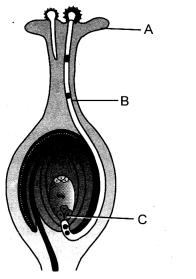
(b) Mention the role of gametes and zygote in sexually reproducing organisms. (CCE 2013, 2015)
Answer:
(a)
A-stigma: Reception of pollen grains and providing nutrients to pollen grains for their germination
B-pollen tube: Carrying of male gametes to inside the ovule for fertilization.
C-egg: Forms zygote and then embryo after fertilization.
(b) Gamete: It is haploid sex cell that brings traits in pure form from its parent for incorporation in the offspring. Zygote. Forms embryo.
Question 34.
(a) Draw a sectional view of human female reproductive system and label the following parts :
(b)
- Where development of egg occurs
- Where fertilization takes place.
Answer:
(a)
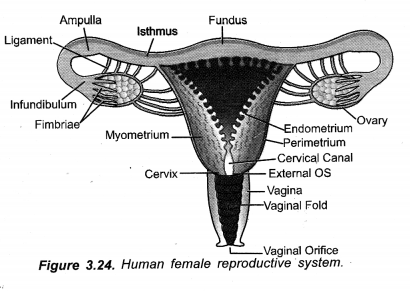
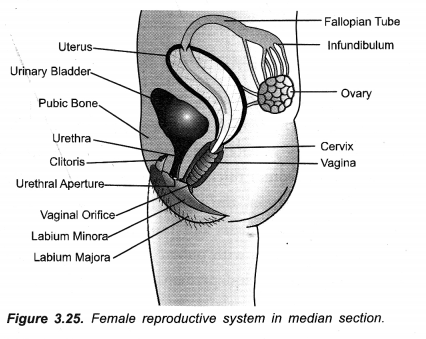
Label
- Ovary
- Fallopian tube.
(b)
- Endometrium thickens, becomes glandular and highly vascular. The contact region between embryo and uterine wall grows into placenta. Placenta helps the embryo in obtaining nourishment and oxygen from blood sinuses of the uterus. It also helps in transfer of wastes from embryo to the blood of the mother.
- Glands present in the mucosa of uterine endometrium begin to degenerate. This sloughs off the endometrial lining, releasing a lot of mucus and blood. It is called menstruation. Menstruation lasts for 3-5 days.
Question 35.
(a) Write the function of placenta in human females,
(b) List four ways of preventing pregnancy. State two advantages of using such preventive methods. (CCE 2013)
Answer:
(a) Placenta: It is a special double layered, spongy tissue connection between the foetus and uternine wall found in pregnant females. It has finger-like outgrowths or villi which are in contact with blood sinuses present in the uterine wall.
Role:
- Attachment: Placenta attaches the foetus to uterine wall.
- Villi: Placenta has finger-like outgrowths or villi which develop a large surface area for fixation and absorption.
- Nutrients: Placenta picks up nutrients from mother’s blood and passes it to the blood of the foetus.
- Waste Products: Waste products produced by the foetus passes out through the placenta into mother’s blood.
- Gases: Foetus obtains oxygen supply from mother’s blood and eliminates carbon dioxide through placenta.
(b) Methods of Contraception:
- Mechanical Barriers like condoms, cervical cap, diaphragm.
- Oral Contraceptives or oral pills like Mala D, Saheli
- Intrauterine Contraceptive Devices (IUCD) like loop, bow, Cu-T.
- Surgical Methods like vasectomy in males and tubectomy in females.
Question 36.
(a) Name the respective part of human female reproductive system
- that produces eggs
- where fusion of egg and sperm takes place and
- where zygote gets implanted.
(b) Describe in brief what happens to the zygote after it gets implanted. (CCE 2014)
Answer:
(a)
- Ovary
- Fallopian tube (isthmus)
- Uterus.
(b) Zygote/blastocyst after implantation grows to form embryo/foetus. The region of implantation forms placenta. The foetus remains attached to placenta by means of umbilical cord. Through placenta, embryo is in contact with blood sinuses of the uterus for obtaining nutrients and elimination of wastes. The fully formed foetus undergoes parturition.
Question 37.
(a) Give an example each of a unisexual and a bisexual flower.
(b) Mention the changes a flower undergoes after fertilization.
How does the amount of DNA remain constant though each new generation is a combination of DNA copies of two individuals ? (CCE 2014)
Answer:
(a) Unisexual Flowers: Papaya.
Bisexual Flower: Mustard.
(b) DNA Amount: The parents are diploid (2n) as each of them has two sets of chromosomes (DNAs). They form haploid (In) male and female gametes through the process of meiosis. The haploid gametes have one set of chromosomes (DNAs). During fertilization, one male gamete fuses with one female gamete. It restores the diploid (2n) chromosome/DNA number in the offspring that is formed from fusion product or zygote (2n).
Question 38.
(a) Write the name of the human male reproductive organ that produces sperms and secretes a hormone.
Describe the changes the uterus undergoes
- to receive the zygote
- if zygote is not formed.
- Name the hormone secreted and state its function.
(b) Write the site of fertilization and the part where the zygote gets implanted in the human female.
(c) State, in brief, how an embryo gets its nourishment inside the mother’s body. (CCE 2014, 2015)
Answer:
(a) Testis. Hormone. Testosterone.
Function of Testosterone
- Regulates sperm formation
- Brings about puberty changes in males.
- Maintains male secondary organs and traits.
(b) Site of Fertilization. Isthmus part of fallopian tube. Site of Implantation. Uterus.
(c) Nourishment of Embryo: Embryo gets nourishment from mother’s body with the help of placenta through a cord called umbilical cord. Placenta contains many finger-like villi from the chorion covering of the embryo. They occur in contact with blood sinuses of the mother present in the endometrial lining of uterus. All nutrients (glucose, amino acids, vitamins, etc.) diffuse from mother’s blood into villi and from there to embryo through the umbilical cord.
Question 39.
(a) Define fragmentation and regeneration,
(b) Can these two methods equated to be the same ? Answer with reason
(c) Give an example each of the organisms using the above methods. (CCE 2014)
Answer:
(a) Fragmentation. It is breaking of an individual into two or more pieces with each piece growing to form the mature individual.
Regeneration. It is the ability of an individual to form lost or broken part, sometimes the whole individual.
(b) The two are not similar. Regeneration involves dedifferentiation, proliferation and differentiation to form lost parts. Fragmentation produces pieces where cells continue to divide resulting in growth of new individual. A repair is not involved.
(c) Regeneration. Hydra, Planaria. Fragmentation. Spirogyra, Marchantia.
Question 40.
Define the following processes :
(a) Fertilization
(b) Vegetative propagation
(c) Menstruation
(d) Regeneration
(e) Binary fission.
Answer:
(a) Fertilization: The union of male gamete (sperm) with the female gamete (ovum) to form a diploid zygote is called fertilization.
(b) Vegetative Propagation: It is the formation of new plants from vegetative parts (e.g., stem, leaf, root, bud) of a parent plant.
(c) Menstruation: It is discharge of blood, mucus and broken pieces of endometrial lining in reproductively active females which occurs for 3-5 days at regular intervals of 28 days (lunar month). It occurs in response to non-fertilization of ovum and non-availability of progesterone hormone.
(d) Regeneration: It is ability of an individual to form lost or broken parts, sometimes the entire individual I from a piece of the parent body. The ability to form the whole individual from a piece of parent body is found only in simple animals like Hydra and Planaria. It does not occur in complex organisms like humans, birds, lizards etc. Here regeneration is limited to repair or regeneration of minor parts. It is because the tissues and organs are highly differentiated in complex animals.
Question 41.
(a) Name the parts labelled A, B, C and D in the diagram.
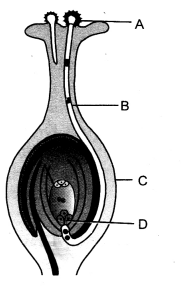
(b) What is pollination ? State its significance.
(c) How does fertilization occur in flowers ? Name the parts of the flower that develop into
- seed and
- fruit after fertilization. (CCE 2014)
Answer:
(a) A—Pollen grain.
B—Pollen tube.
C—ovary.
D—Egg/oosphere.
(b) Pollination. The transfer of pollen grains from anther to the stigma of a flower is called pollination.
Singificance. It carries the immobile pollen grains to the stigma for formation of male gametophyte and fertilization.
(c) After falling on a suitable stigma the pollen absorbs water and nutrients. It produces a pollen tube that grows through the style and reaches the ovary. Its tip contains a tube nucleus and two male gametes. The pollen tube enters an ovule, strikes against one synergid of the embryo sac and bursts open to release its contents. One male gamete fuses with the egg to form zygote while the other fuses with secondary nucleus to produce primary endosperm nucleus.
- Seed—ovule,
- Fruit—ovary.
Question 42.
(a) Identify the leaf shown.
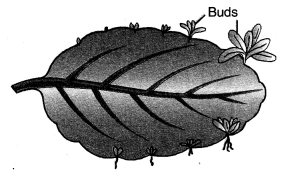
(b) Name the method used by the above leaf for reproduction.
(c) Give three advantages for the method used.
(d) Give two examples of plants which can be grown by this method.
(CCE 2015)
Answer:
(a) Bryophyllum
(b) Vegetative propagation
(c)
- It is quicker method of propagation.
- It gives rise to a genetically uniform propagation.
- Good qualities of a variety can be maintained indefinitely.
(d) Sugarcane, Bougainvillea.
Question 43.
Justify the following statements :
(a) Variation is beneficial for the species over a period of time.
(b) New offspring produced are similar to their parents, but not identical
(c) Binary fission is different in Amoeba and Leishmania.
Answer:
a) Many of the variations are pre-adaptations which have no immediate benefit to the individuals. However, they remain in the population. Whenever, environment undergoes a drastic change, the pre-adaptations present in some members of the population allow the latter to survive, grow and regain its former size. Therefore, it is not necessary that variations are beneficial to individuals developing them but can prove useful to the species.
(b) New offspring are similar to their parents because they have obtained the genetic traits from the same. They are, however, not identical because of chance separation, chance combination of chromosomes and recombination of genes due to crossing over.
(c) In Amoeba, binary fission can occur in any plane. In Leishmania the plane of division is vertical.
Question 44.
Explain what happens when :
(a) Testosterone is released in males
(b) Pollen grain falls on the stigma of the flower,
(e) Egg fuses with sperm cell,
(d) Planaria is cut into many pieces,
(e) Buds are formed at the notches of Bryophyllum leaf. (CCE 2015)
Answer:
(a) Testosterone,
- Regulates formation of sperms,
- Puberty changes in boys.
- Maintenance of secondary sexual characters in males.
(b) Pollen Grain. If pollen grain and stigma are compatible, the pollen grain absorbs water and nutrients from the stigma. It germinates and forms a pollen tube. Pollen tube passes into stigma and then style for reaching the ovary.
(c) Egg Fuses with Sperm Cell. The act is called fertilization. It produces a diploid zygote which later on grows into embryo.
(d) Cutting of Planaria. Each piece begins to regenerate, anterior end forms the anterior body parts, while posterior end gives rise to posterior body parts. Regeneration occurs with the help of stem cells and dedifferentiated cells (from differented ones).
(e) Bryophyllum Leaf. Buds present in the marginal notches of Bryophyllum leaf sprout and produce plantlets under suitable conditions. They help in vegetative multiplication.
Question 45.
Differentiate between the following :
(a) Pollen tube and style,
(b) Fission in Amoeba and Plasmodium,
(c) Fragmentation and Regeneration,
(d) Bud of Hydra and Bryophyllum.
(e) Vegetative propagation and spore formation. (CCE 2015)
Answer:
(a) Pollen Tube and Style: Pollen tube is an outgrowth of pollen grain meant for carrying the male gametes to ovule. Style is a stalk-like structure of carpel (= pistil) that is meant for lifting the stigma above the level of ovary.
(b) Fission in Amoeba and Plasmodium: Under favourable conditions Amoeba multiplies by binary fission while Plasmodium multiplies by multiple fission.
(c) Fragmentation and Regeneration :
Fragmentation: It is breaking of an individual into two or more pieces with each piece growing to form the mature individual.
Regeneration: It is the ability of an individual to form lost or broken part, sometimes the whole individual.(d) Bud of Hydra and Bud of Bryophyllum. In Hydra, bud is an outgrowth of the body which gets transformed into new animal that separates to lead an independent life. In Bryophyllum buds develop from the notches of the leaf. After falling on ground, the buds sprout and from plantlets.
(e) Vegetative Propagation and Spore Formation: In vegetative propagation new plants develop from specialised or unspecialised multicellular parts of the parent plant that function as propagules, e.g., Bryophyllum. Sugarcane. In spore formation, the individual parent produces unicellular reproductive bodies that get dispersed and form new individuals on germination, e.g, Rhizopus.
Question 46.
(a) Write the functions of the following parts in human female resproductive system :
- Ovary
- Oviduct
- Uterus.
(b) Describe the structure and function of placenta. (CBSE Delhi 2016, A.I. 2017)
Answer:
(a)
- Ovary. Formation of ova and secretion of hormones, estrogen and progesterone.
- Fallopian Tube. Passage of ovum, site for fertilization.
- Uterus. Implantation and nourishment of embryo.
(b) Placenta: It is a special double layered, spongy tissue connection between the foetus and uternine wall found in pregnant females. It has finger-like outgrowths or villi which are in contact with blood sinuses present in the uterine wall.
Role:
- Attachment: Placenta attaches the foetus to uterine wall.
- Villi: Placenta has finger-like outgrowths or villi which develop a large surface area for fixation and absorption.
- Nutrients: Placenta picks up nutrients from mother’s blood and passes it to the blood of the foetus.
- Waste Products: Waste products produced by the foetus passes out through the placenta into mother’s blood.
- Gases: Foetus obtains oxygen supply from mother’s blood and eliminates carbon dioxide through placenta.
Question 47.
(a) What is vegetative propagation ? List with brief explanation three advantages of practising this process for growing some types of plants.
(b) Select two plants from the following which are grown by this process : Banana, Wheat, Mustard, Jasmine,
Gram. (CBSE Foreign 2016)
Answer:
(a) Vegetative propagation is the formation of new plants by using vegetative parts of a parent plant as propagules e.g., stem (Sugarcane, Bougainvillea, Potato), root (Sweet Potato, Dahlia), leaf (Bryophyllum), bud (Agave).
Advantages:
- It is the only known method of multiplication of seedless plants like Banana and Sugarcane.
- It is a quicker method as vegetatively reproduced plants bear flowers and fruits earlier than plants raised through seeds.
- All the individual plants are clones of one another and their parent so that the crop is genetically uniform.
- Good quality of a variety can be maintained indefinitely.
(b) Banana, Jasmine.
Question 48.
(a) State in brief the function of the following organs in the human female reproductive system : Ovary, Fallopian tube, Uterus.
(i) What is menstruation ? Why does it occur ? (CBSE Foreign 2016)
Answer:
(a)
- Ovary: Formation of ova and secretion of hormones, estrogen and progesterone.
- Fallopian Tube: Passage of ovum, site for fertilization.
- Uterus: Implantation and nourishment of embryo.
(b) Menstruation:
It is discharge of blood, mucus and broken pieces of endometrial lining in reproductively active females which occurs for 3-5 days at regular intervals of 28 days (lunar month). It occurs in response to non-fertilization of ovum and non-availability of progesterone hormone.
Question 49.
(a) Name the organ that produces sperms as hormone it secretes and write its functions.
(b) Name the parts of the human female reproductive system where fertilisation occurs.
(c) Explain how the develeping embryo gets nourishment inside the mother’s body. (CBSE Delhi 2017)
Answer:
(a) Testes: Hormone produced by testes is testosterone.
Functions of Testosterone:
- Regulates formation of sperms,
- Puberty changes in boys.
- Maintenance of secondary sexual characters in males.
(b) Isthmus part of fallopian tube or oriduct.
(c) Developing embryo obtains nourishment from the mother with the help of placenta. The foetal part of placenta has a number of finger-like outgrowths called villi. Villi are in near contact with blood sinuses representing the maternal part of placenta. There is a large surface area between the two. It helps in easy passage of nutrients from mother’s blood sinuses into blood of the umbilical cord of the foetus.
Question 50.
Give one example each of unisexual and bisexual flowers. Differentiate between the two types of pollination that occur in flowers. What happens when a pollen lands on a suitable stigma ? Write about the events that occur till the seed formation in the ovary. (CBSE Foreign 2017)
Answer:
Unisexual Flower. Papaya, Cucurbita Bisexual Flower. Mustard, Hibiscus.
Types of Pollination. It is of two types, self pollination and cross pollination. Self pollination is the transfer of pollen from the anther to the stigma of the same flower. Cross pollination is the transfer of pollen grains from the anther of one flower to the stigma of another flower.
Events After Pollination. After falling on a suitable stigma, the pollen grain absorbs water and nutrients. It produces a pollen tube. The pollen tube carries two male gametes. It grows through style, reaches the ovary and enters an ovule. Inside the ovle, the tip of pollen tube bursts and releases the two male gametes. One male gamete fuses with the egg to produce diploid zygote. The other male gamete fuses with the diplod central cell of embryo sac to form primary endosperm cell. Zygote grows into embryo. Primary endosperm cell forms nutritive tissue called endosperm. Endosperm may or may not be consumed by the embryo. Integuments of ovule are changed into seed coats. The ovule is transformed into seed (and ovary into fruit).
Hope given Previous Year Question Papers for CBSE Class 10 Science Chapter 8 How do Organisms Reproduce? are helpful to complete your science homework.
If you have any doubts, please comment below. Learn Insta try to provide online science tutoring for you.


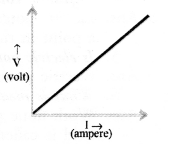
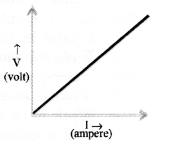
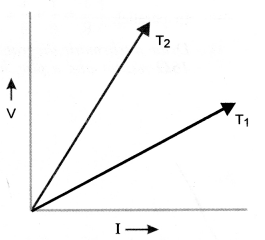
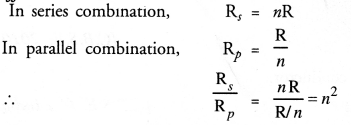

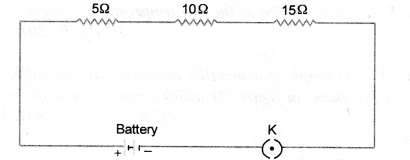



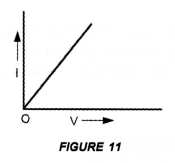
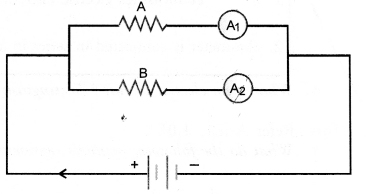

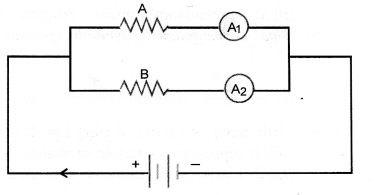
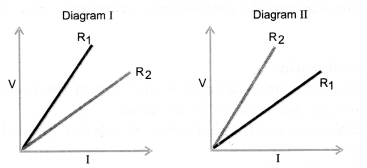
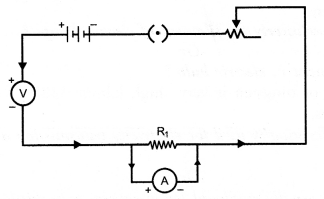



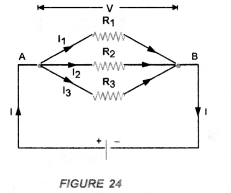



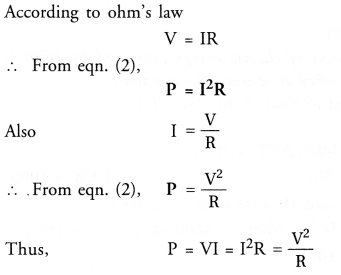


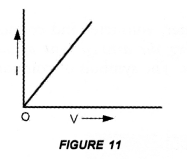
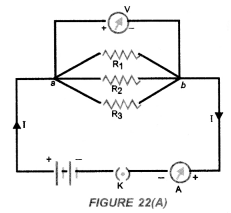

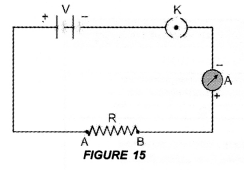


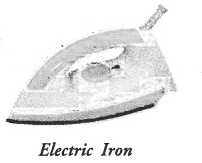
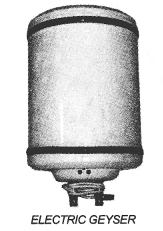
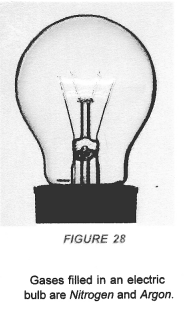

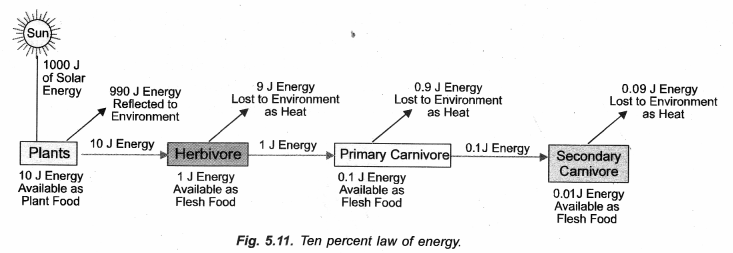
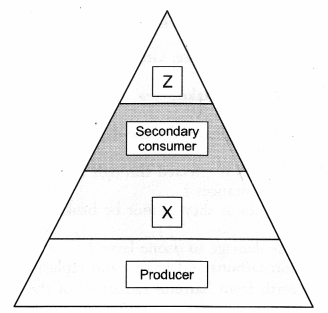













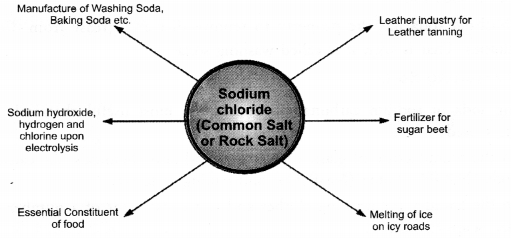
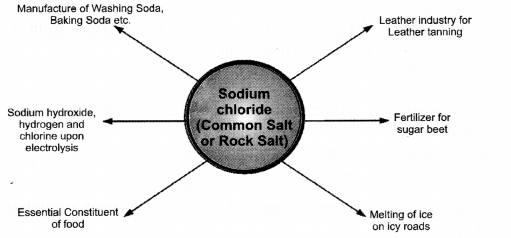







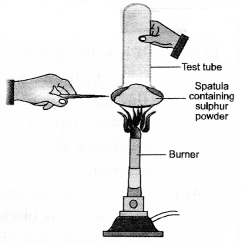




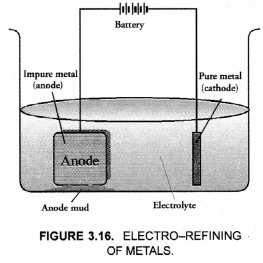 The electrolyte is the solution of the soluble salt of the same metal, preferably a double salt. On passing electric current, metal ions from the electrolyte are reduced to the metal which is deposited on the cathode. An equivalent amount of the pure metal from the anode gets oxidised and the metal ions (or cations) go into the solution. This keeps on till the whole of the metal from the anode dissolves and deposits on cathode, leaving behind impurities in the form of a mud called anode mud.
The electrolyte is the solution of the soluble salt of the same metal, preferably a double salt. On passing electric current, metal ions from the electrolyte are reduced to the metal which is deposited on the cathode. An equivalent amount of the pure metal from the anode gets oxidised and the metal ions (or cations) go into the solution. This keeps on till the whole of the metal from the anode dissolves and deposits on cathode, leaving behind impurities in the form of a mud called anode mud.





